Firetide 5900-1 5900 Mesh Node User Manual 5900 HotViewPro Manual 3 Part 1
Firetide Inc. 5900 Mesh Node 5900 HotViewPro Manual 3 Part 1
Firetide >
Contents
- 1. 5900_HotViewPro_Manual_3 Part 1
- 2. 5900_HotViewPro_Manual_3 Part 2
- 3. Quick Installation Guide
- 4. User Manual Part 1
- 5. User Manual Part 2
5900_HotViewPro_Manual_3 Part 1
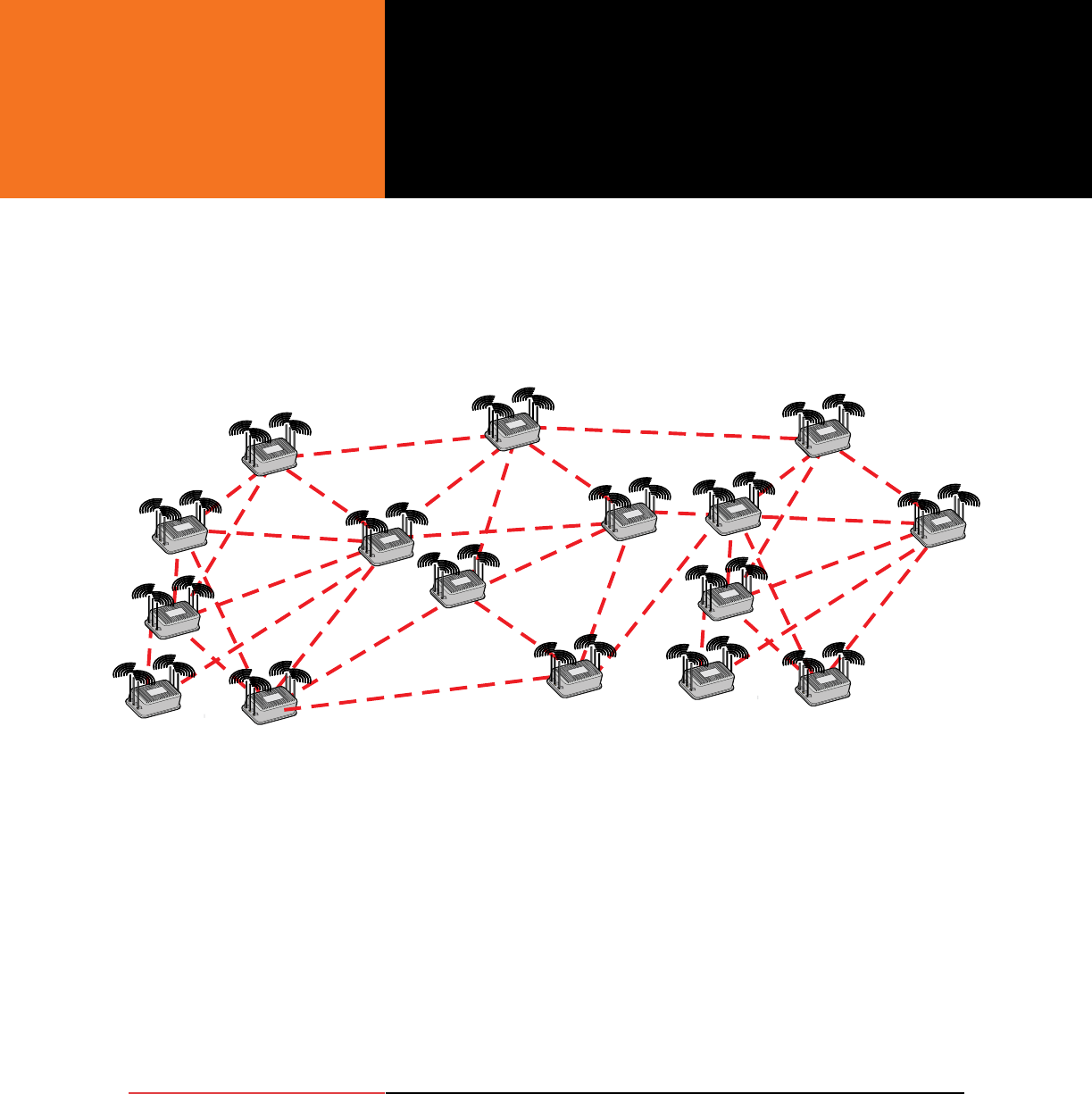
Reference
Guide
Aclara 5900M
Software Operation
Software Version 0.1.3.7
Manual Version 1.0draft2. Release Date 2012-02-13. Please refer to the Firetide web site, www.retide.com, for current versions.
The contents of this Reference Guide are subject to change without notice. Firetide, the Firetide logo, HotView, Wireless Instant
Networks, and Reliable Connectivity Anywhere are trademarks of Firetide, Inc. © 2005-2012 Firetide, Inc. All rights reserved.

2 HotView Pro Software Operation
Contents
1 Introduction 5
2 HotView Pro Command Summary 7
Launching HotView Pro . . . . . . . . . . . . . . . . . . . . . . . . . . . . . . . . . . . . . . . . . . . . . 7
Understand the Basic Screen Layout . . . . . . . . . . . . . . . . . . . . . . . . . . . . . . . . . . . . . . . 9
Mesh Menu Commands . . . . . . . . . . . . . . . . . . . . . . . . . . . . . . . . . . . . . . . . . . . . 10
DCU Communication Conguration . . . . . . . . . . . . . . . . . . . . . . . . . . . . . . . . . . . . . . . 11
Mesh Conguration . . . . . . . . . . . . . . . . . . . . . . . . . . . . . . . . . . . . . . . . . . . . . . 12
Node Commands . . . . . . . . . . . . . . . . . . . . . . . . . . . . . . . . . . . . . . . . . . . . . . . 15
Individual Radio Settings . . . . . . . . . . . . . . . . . . . . . . . . . . . . . . . . . . . . . . . . . . . 17
Client Preferences. . . . . . . . . . . . . . . . . . . . . . . . . . . . . . . . . . . . . . . . . . . . . . . 19
Server Administration . . . . . . . . . . . . . . . . . . . . . . . . . . . . . . . . . . . . . . . . . . . . . 20
3 Analyzing Performance 21
Aspects of Performance Analysis . . . . . . . . . . . . . . . . . . . . . . . . . . . . . . . . . . . . . . . . 21
RF Signal Quality . . . . . . . . . . . . . . . . . . . . . . . . . . . . . . . . . . . . . . . . . . . . . . . 21
Link Throughput . . . . . . . . . . . . . . . . . . . . . . . . . . . . . . . . . . . . . . . . . . . . . . . 24
Performance Optimization . . . . . . . . . . . . . . . . . . . . . . . . . . . . . . . . . . . . . . . . . . . 25
4 HotView Pro Server Conguration 27
Server Conguration - Network Management . . . . . . . . . . . . . . . . . . . . . . . . . . . . . . . . . . . 27
Server Conguration - Service Manager . . . . . . . . . . . . . . . . . . . . . . . . . . . . . . . . . . . . . 28
Server Conguration - User Management . . . . . . . . . . . . . . . . . . . . . . . . . . . . . . . . . . . . 28
Server Conguration - Windows Service Manager . . . . . . . . . . . . . . . . . . . . . . . . . . . . . . . . . 29
Server Conguration - SNMP Setup . . . . . . . . . . . . . . . . . . . . . . . . . . . . . . . . . . . . . . . 29
Server Conguration - Alarm Management . . . . . . . . . . . . . . . . . . . . . . . . . . . . . . . . . . . . 30
Server Conguration - Security . . . . . . . . . . . . . . . . . . . . . . . . . . . . . . . . . . . . . . . . . 32
5 Upgrading Firmware 33
6 Enabling Radios & MIMO Operation 37
7 Keeping the Mesh Secure 39
Radio Security . . . . . . . . . . . . . . . . . . . . . . . . . . . . . . . . . . . . . . . . . . . . . . . . 40
Mesh Connection Security . . . . . . . . . . . . . . . . . . . . . . . . . . . . . . . . . . . . . . . . . . . 41
User Security. . . . . . . . . . . . . . . . . . . . . . . . . . . . . . . . . . . . . . . . . . . . . . . . . 44
8 Conguring an Ethernet Direct Connection 47
Tearing Down an Ethernet Direct Connection . . . . . . . . . . . . . . . . . . . . . . . . . . . . . . . . . . 50
9 Creating Gateway Groups 51
Steps to Create a Gateway Group . . . . . . . . . . . . . . . . . . . . . . . . . . . . . . . . . . . . . . . . 52
10 Multicast 57
Creating a Multicast Group. . . . . . . . . . . . . . . . . . . . . . . . . . . . . . . . . . . . . . . . . . . 58
11 VLANs 61
Implementing VLANs . . . . . . . . . . . . . . . . . . . . . . . . . . . . . . . . . . . . . . . . . . . . . 63
Appendix A Regulatory Information 67
DFS Notice . . . . . . . . . . . . . . . . . . . . . . . . . . . . . . . . . . . . . . . . . . . . . . . . . . 68
Canadian Compliance Statement . . . . . . . . . . . . . . . . . . . . . . . . . . . . . . . . . . . . . . . . 68

3
List of Figures
Figure 1.1 The Aclara STAR Network . . . . . . . . . . . . . . . . . . . . . . . . . . . . . . . . . . . . . .5
Figure 1.2 Launcher Icon . . . . . . . . . . . . . . . . . . . . . . . . . . . . . . . . . . . . . . . . . . 7
Figure 1.3 Launcher Window . . . . . . . . . . . . . . . . . . . . . . . . . . . . . . . . . . . . . . . . . 7
Figure 1.4 Initial Screen . . . . . . . . . . . . . . . . . . . . . . . . . . . . . . . . . . . . . . . . . . .8
Figure 1.5 Adding a Mesh . . . . . . . . . . . . . . . . . . . . . . . . . . . . . . . . . . . . . . . . . . 8
Figure 1.6 Menu Commands . . . . . . . . . . . . . . . . . . . . . . . . . . . . . . . . . . . . . . . . . 8
Figure 1.7 Typical Screen Image . . . . . . . . . . . . . . . . . . . . . . . . . . . . . . . . . . . . . . . 9
Figure 1.9 Node Icons . . . . . . . . . . . . . . . . . . . . . . . . . . . . . . . . . . . . . . . . . . . .9
Figure 1.8 Mesh Tab Commands. . . . . . . . . . . . . . . . . . . . . . . . . . . . . . . . . . . . . . . .9
Figure 1.10 Mesh Menu . . . . . . . . . . . . . . . . . . . . . . . . . . . . . . . . . . . . . . . . . . . 10
Figure 1.11 Right-Click Mesh Menu . . . . . . . . . . . . . . . . . . . . . . . . . . . . . . . . . . . . . . 11
Figure 1.12 DCU Communication Conguration - Auto Detect vs Manual . . . . . . . . . . . . . . . . . . . . . 11
Figure 1.13 Mesh Conguration . . . . . . . . . . . . . . . . . . . . . . . . . . . . . . . . . . . . . . . 12
Figure 1.14 Wireless Settings . . . . . . . . . . . . . . . . . . . . . . . . . . . . . . . . . . . . . . . . 13
Figure 1.15 Security . . . . . . . . . . . . . . . . . . . . . . . . . . . . . . . . . . . . . . . . . . . . 14
Figure 1.16 Advanced Tab . . . . . . . . . . . . . . . . . . . . . . . . . . . . . . . . . . . . . . . . . . 14
Figure 1.17 Node-Specic . . . . . . . . . . . . . . . . . . . . . . . . . . . . . . . . . . . . . . . . . . 15
Figure 1.18 Location Dialog Window . . . . . . . . . . . . . . . . . . . . . . . . . . . . . . . . . . . . . 15
Figure 1.19 Node Radio Settings . . . . . . . . . . . . . . . . . . . . . . . . . . . . . . . . . . . . . . . 17
Figure 1.20 Node QoS. . . . . . . . . . . . . . . . . . . . . . . . . . . . . . . . . . . . . . . . . . . . 18
Figure 1.21 Client Preferences . . . . . . . . . . . . . . . . . . . . . . . . . . . . . . . . . . . . . . . . 19
Figure 1.22 Server Administration Menu . . . . . . . . . . . . . . . . . . . . . . . . . . . . . . . . . . . 20
Figure 2.23 Node Statistics . . . . . . . . . . . . . . . . . . . . . . . . . . . . . . . . . . . . . . . . . 22
Figure 2.24 Link Statistics . . . . . . . . . . . . . . . . . . . . . . . . . . . . . . . . . . . . . . . . . 22
Figure 2.25 Spectrum Analysis Setup . . . . . . . . . . . . . . . . . . . . . . . . . . . . . . . . . . . . . 23
Figure 2.26 Spectrum Analysis Setup . . . . . . . . . . . . . . . . . . . . . . . . . . . . . . . . . . . . . 23
Figure 2.27 Diagnostic Tools . . . . . . . . . . . . . . . . . . . . . . . . . . . . . . . . . . . . . . . . 24
Figure 2.28 Diagnostic Tool Selection . . . . . . . . . . . . . . . . . . . . . . . . . . . . . . . . . . . . 24
Figure 2.29 Link Elimination . . . . . . . . . . . . . . . . . . . . . . . . . . . . . . . . . . . . . . . . 25
Figure 2.30 Fixing Data Rates . . . . . . . . . . . . . . . . . . . . . . . . . . . . . . . . . . . . . . . . 25
Figure 3.31 Server Conguration - Network Management . . . . . . . . . . . . . . . . . . . . . . . . . . . . 27
Figure 3.32 Mesh User Accounts . . . . . . . . . . . . . . . . . . . . . . . . . . . . . . . . . . . . . . . 27
Figure 3.33 Service Manager. . . . . . . . . . . . . . . . . . . . . . . . . . . . . . . . . . . . . . . . . 28
Figure 3.34 HotView Pro Management - Users Tab . . . . . . . . . . . . . . . . . . . . . . . . . . . . . . . 28
Figure 3.35 HotView Pro Management - Windows Service Tab . . . . . . . . . . . . . . . . . . . . . . . . . . 29
Figure 3.36 HotView Pro Management - SNMP Tab . . . . . . . . . . . . . . . . . . . . . . . . . . . . . . . 29
Figure 3.37 Alarm Management . . . . . . . . . . . . . . . . . . . . . . . . . . . . . . . . . . . . . . . 30
Figure 3.38 Alarm Conguration - Severity . . . . . . . . . . . . . . . . . . . . . . . . . . . . . . . . . . 30
Figure 3.39 Alarm Events . . . . . . . . . . . . . . . . . . . . . . . . . . . . . . . . . . . . . . . . . . 31
Figure 3.40 Alarm Actions. . . . . . . . . . . . . . . . . . . . . . . . . . . . . . . . . . . . . . . . . . 31
Figure 3.41 Security . . . . . . . . . . . . . . . . . . . . . . . . . . . . . . . . . . . . . . . . . . . . 32
Figure 4.42 Firmware Upgrade . . . . . . . . . . . . . . . . . . . . . . . . . . . . . . . . . . . . . . . . 34
Figure 4.43 Upgrade in Progress . . . . . . . . . . . . . . . . . . . . . . . . . . . . . . . . . . . . . . . 35
Figure 4.44 Completion & Activation . . . . . . . . . . . . . . . . . . . . . . . . . . . . . . . . . . . . . 35
Figure 4.45 Upgrade Chunk Size . . . . . . . . . . . . . . . . . . . . . . . . . . . . . . . . . . . . . . . 35
Figure 5.46 Enabling the Second Radio . . . . . . . . . . . . . . . . . . . . . . . . . . . . . . . . . . . . 37
Figure 5.47 Selecting Nodes to Upgrade . . . . . . . . . . . . . . . . . . . . . . . . . . . . . . . . . . . 38
Figure 5.48 Ready for Upgrade. . . . . . . . . . . . . . . . . . . . . . . . . . . . . . . . . . . . . . . . 38
Figure 6.49 Enabling Radio Encryption . . . . . . . . . . . . . . . . . . . . . . . . . . . . . . . . . . . . 40
Figure 6.50 End-to-End Encryption. . . . . . . . . . . . . . . . . . . . . . . . . . . . . . . . . . . . . . 40
Figure 6.51 High Security Mode . . . . . . . . . . . . . . . . . . . . . . . . . . . . . . . . . . . . . . . 41
Figure 6.52 Adding a Trusted Node. . . . . . . . . . . . . . . . . . . . . . . . . . . . . . . . . . . . . . 41
Figure 6.53 Active and Disabled Ethernet Ports . . . . . . . . . . . . . . . . . . . . . . . . . . . . . . . . 42
Figure 6.54 Disabling Ports . . . . . . . . . . . . . . . . . . . . . . . . . . . . . . . . . . . . . . . . . 42

4 HotView Pro Software Operation
Figure 6.55 MAC Address Filtering . . . . . . . . . . . . . . . . . . . . . . . . . . . . . . . . . . . . . . 43
Figure 6.56 Mesh Login Credential - Mesh. . . . . . . . . . . . . . . . . . . . . . . . . . . . . . . . . . . 44
Figure 6.57 Mesh Login Credential - HotView Pro Server . . . . . . . . . . . . . . . . . . . . . . . . . . . . 44
Figure 6.58 User Denitions. . . . . . . . . . . . . . . . . . . . . . . . . . . . . . . . . . . . . . . . . 45
Figure 6.59 User Lockout . . . . . . . . . . . . . . . . . . . . . . . . . . . . . . . . . . . . . . . . . . 46
Figure 6.60 Remote Access User Conguration . . . . . . . . . . . . . . . . . . . . . . . . . . . . . . . . 46
Figure 7.61 Ethernet Direct - Initial Data Entry . . . . . . . . . . . . . . . . . . . . . . . . . . . . . . . . 47
Figure 7.62 Far-End Tunnel Endpoint . . . . . . . . . . . . . . . . . . . . . . . . . . . . . . . . . . . . . 48
Figure 7.63 Completed Tunnel . . . . . . . . . . . . . . . . . . . . . . . . . . . . . . . . . . . . . . . . 49
Figure 7.64 Completed Ethernet Direct . . . . . . . . . . . . . . . . . . . . . . . . . . . . . . . . . . . . 49
Figure 7.65 Ethernet Direct Port Disable Warning . . . . . . . . . . . . . . . . . . . . . . . . . . . . . . . 50
Figure 7.66 Disabled Port Indication . . . . . . . . . . . . . . . . . . . . . . . . . . . . . . . . . . . . . 50
Figure 8.67 Basic Gateway Group . . . . . . . . . . . . . . . . . . . . . . . . . . . . . . . . . . . . . . 51
Figure 8.68 Creating a Gateway Server Node . . . . . . . . . . . . . . . . . . . . . . . . . . . . . . . . . 52
Figure 8.69 Gateway Server Icon. . . . . . . . . . . . . . . . . . . . . . . . . . . . . . . . . . . . . . . 52
Figure 8.70 Gateway Server Settings, Part One . . . . . . . . . . . . . . . . . . . . . . . . . . . . . . . . 53
Figure 8.71 Gateway Server Settings, Part Two . . . . . . . . . . . . . . . . . . . . . . . . . . . . . . . . 53
Figure 8.72 Gateway Interface Settings. . . . . . . . . . . . . . . . . . . . . . . . . . . . . . . . . . . . 54
Figure 8.73 First Gateway Group Link Up . . . . . . . . . . . . . . . . . . . . . . . . . . . . . . . . . . . 54
Figure 8.74 Gateway Server Settings . . . . . . . . . . . . . . . . . . . . . . . . . . . . . . . . . . . . . 55
Figure 8.75 Completed Gateway Group . . . . . . . . . . . . . . . . . . . . . . . . . . . . . . . . . . . . 55
Figure 9.76 Disabling Multicast . . . . . . . . . . . . . . . . . . . . . . . . . . . . . . . . . . . . . . . 57
Figure 9.77 Creating a Multicast Group . . . . . . . . . . . . . . . . . . . . . . . . . . . . . . . . . . . . 58
Figure 9.78 New Multicast Window . . . . . . . . . . . . . . . . . . . . . . . . . . . . . . . . . . . . . . 58
Figure 9.79 A Completed Multicast Group . . . . . . . . . . . . . . . . . . . . . . . . . . . . . . . . . . . 58
Figure 9.80 Completed Multicast Groups . . . . . . . . . . . . . . . . . . . . . . . . . . . . . . . . . . . 59
Figure 9.81 Allowing All Multicast Trafc . . . . . . . . . . . . . . . . . . . . . . . . . . . . . . . . . . . 59
Figure 9.82 Reserved Addresses . . . . . . . . . . . . . . . . . . . . . . . . . . . . . . . . . . . . . . . 60
Figure 10.83 Three Separate LANs. . . . . . . . . . . . . . . . . . . . . . . . . . . . . . . . . . . . . . . 61
Figure 10.84 VLAN Implementation of Three Separate LANs . . . . . . . . . . . . . . . . . . . . . . . . . . . 61
Figure 10.85 Three Virtual Access Points on Three VLANs . . . . . . . . . . . . . . . . . . . . . . . . . . . . 62
Figure 10.86 VLAN Creation Window. . . . . . . . . . . . . . . . . . . . . . . . . . . . . . . . . . . . . . 63
Figure 10.87 VLAN Port Assignment Window . . . . . . . . . . . . . . . . . . . . . . . . . . . . . . . . . . 63
Figure 10.88 Multiple VLAN Assignments. . . . . . . . . . . . . . . . . . . . . . . . . . . . . . . . . . . . 63
Figure 10.89 Editing VLANs and VLAN Trunks. . . . . . . . . . . . . . . . . . . . . . . . . . . . . . . . . . 64
Figure 10.90 The VLAN Trunk Window . . . . . . . . . . . . . . . . . . . . . . . . . . . . . . . . . . . . . 64
Figure 10.91 Conguring a VLAN Trunk . . . . . . . . . . . . . . . . . . . . . . . . . . . . . . . . . . . . 65
Figure 10.92 Hybrid VLAN Conguration . . . . . . . . . . . . . . . . . . . . . . . . . . . . . . . . . . . . 65
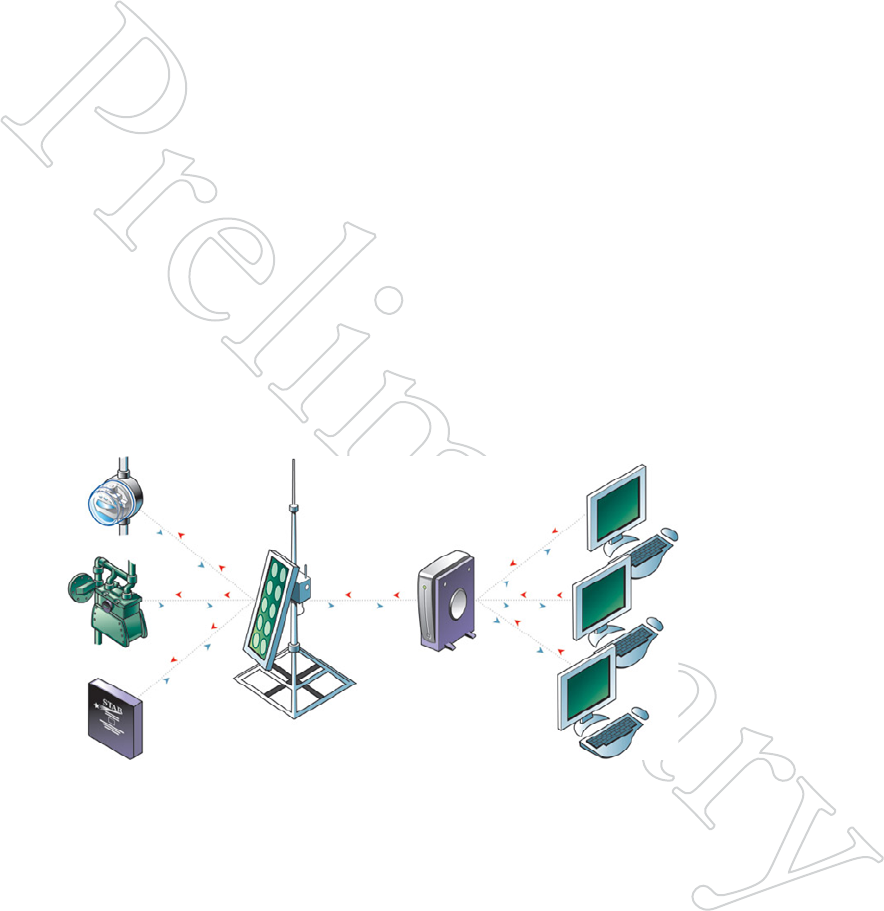
Introduction 5
1 Introduction
Aclara’s STAR Network system is a meter reading solution that delivers
comprehensive usage information through a secure, long-range wireless
network. A portion of that network is implement using Firetide’s patented
AutoMesh™ wireless Ethernet system.
STAR NeTwoRk CompoNeNTS
The STAR Network Meter Transmission Units (MTUs) are small, perma-
nently sealed modules that are connected to water meters or are integrated
into electric and gas meters. MTUs read the meter and forward the meter
data. These messages are received by one of several Data Collector Units
that cover the service area.
STAR Network Data Collector Units (DCUs) are intelligent network de-
vices that receive, process, and store meter reading information transmitted
from STAR Network MTUs. The DCUs forward this information to the
STAR Network Control Computer (NCC) located at the utility. DCUs
connect to the NCC by a variety of backhaul communication networks,
including fiber optic, WiFi, and cellular. The WiFi method is implemented
with products based on Firetide’s technology, and engineered to meet the
specific requirements of Aclara.
Figure 1.1 The AclArA STAr
NeTwork
The STAR Network Control Computer (NCC) collects, validates, pro-
cesses, and stores data transmitted by the STAR Network DCUs. .
NoTe
This equipment emits RF energy
and has received regulatory approv-
al in its country of origin.
Changes or modifications not ex-
pressly approved by the party re-
sponsible for compliance could
void the user’s authority to oper-
ate the equipment.
Please refer to the appendix for ad-
ditional regulatory information.

6 HotView Pro Software Operation
Aclara 5900 Series units use Firetide’s AutoMesh WiFi technology. Firetide’s
HotView Pro Network Management System is the control platform for
these units. The version of HotView Pro you are using has been tailored to
the requirements of Aclara’s STAR system.
“Command Summary” on page 7 provides a summary of the commands
available in HotView Pro, with a brief description of their function and
purpose. Further information on the more complex commands may be
found in later chapters.
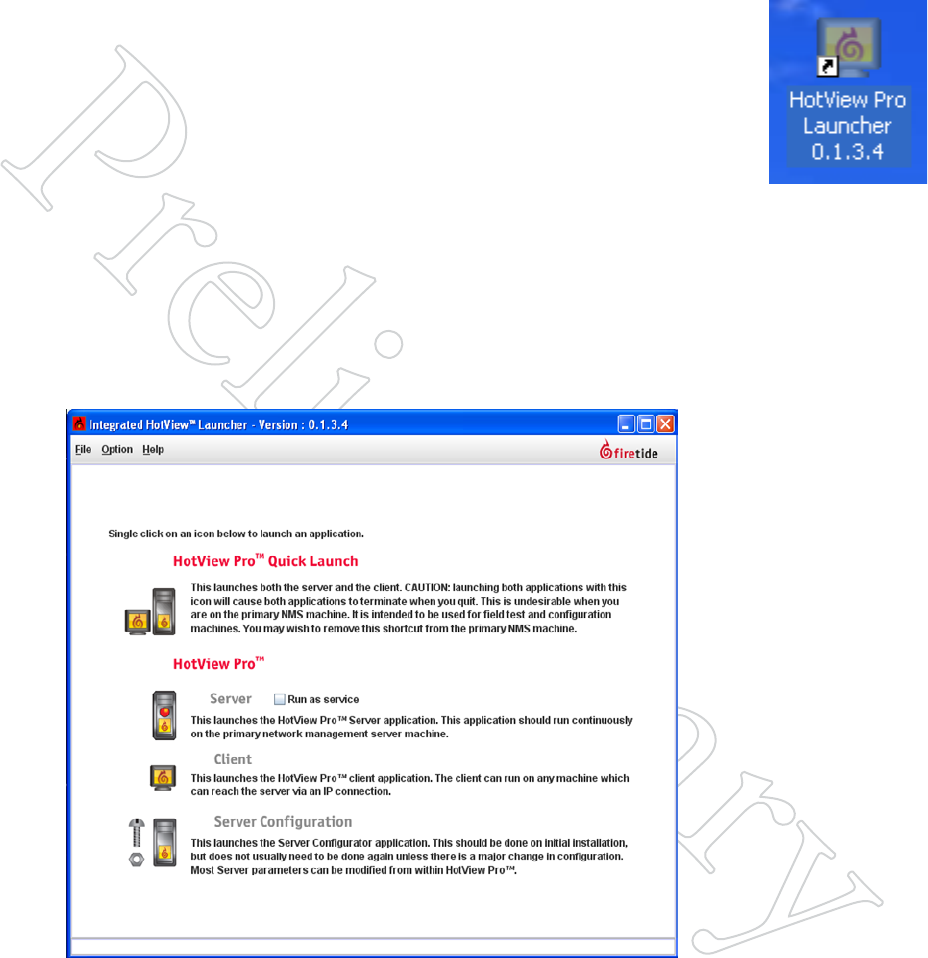
HotView Pro Command Summary 7
2 HotView Pro Command Summary
This version of HotView Pro is tailored to the requirements of Aclara’s
STAR system. It is focussed on the 5900 family of products, but also shows
other HotPort mesh nodes in some examples.
This chapter provides a summary of the commands available in HotView Pro,
with a brief description of their function and purpose. Further information
on the more complex commands may be found in later chapters.
Launching HotView Pro
The software is started via the desktop shortcut created by the installation
process, shown in Figure 1.2. If this icon is not visible, the launcher applica-
tion can be accessed via the Windows Start menu.
If you plan to connect to an already-deployed mesh, single-click on the
client application icon in the launcher window, and enter the IP address of
the server.
Figure 1.2 lAuNcher icoN
Double-click to launch the software.
Your version number may be different.
Figure 1.3 lAuNcher wiNdow
Quick Launch is used in test and
debug environments. It launches both
the server application and the client
application; when the client applica-
tion is closed; the server application
terminates.
The Server icon launches the server
application; it will remain running
until it is manually terminated. If the
‘LED’ is red, the server is not running;
if it is green, the server is running.
The Client icon launches the client
application.
Server Configuration is used for
initial server setup, and also to manage
users and other system-wide settings.
If you plan to test and configure units on the bench, use the quick launch
icon. However, do not do this unless you are sure there is not another copy
of the server application managing the mesh. A mesh cannot be managed
by two different server applications simultaneously.
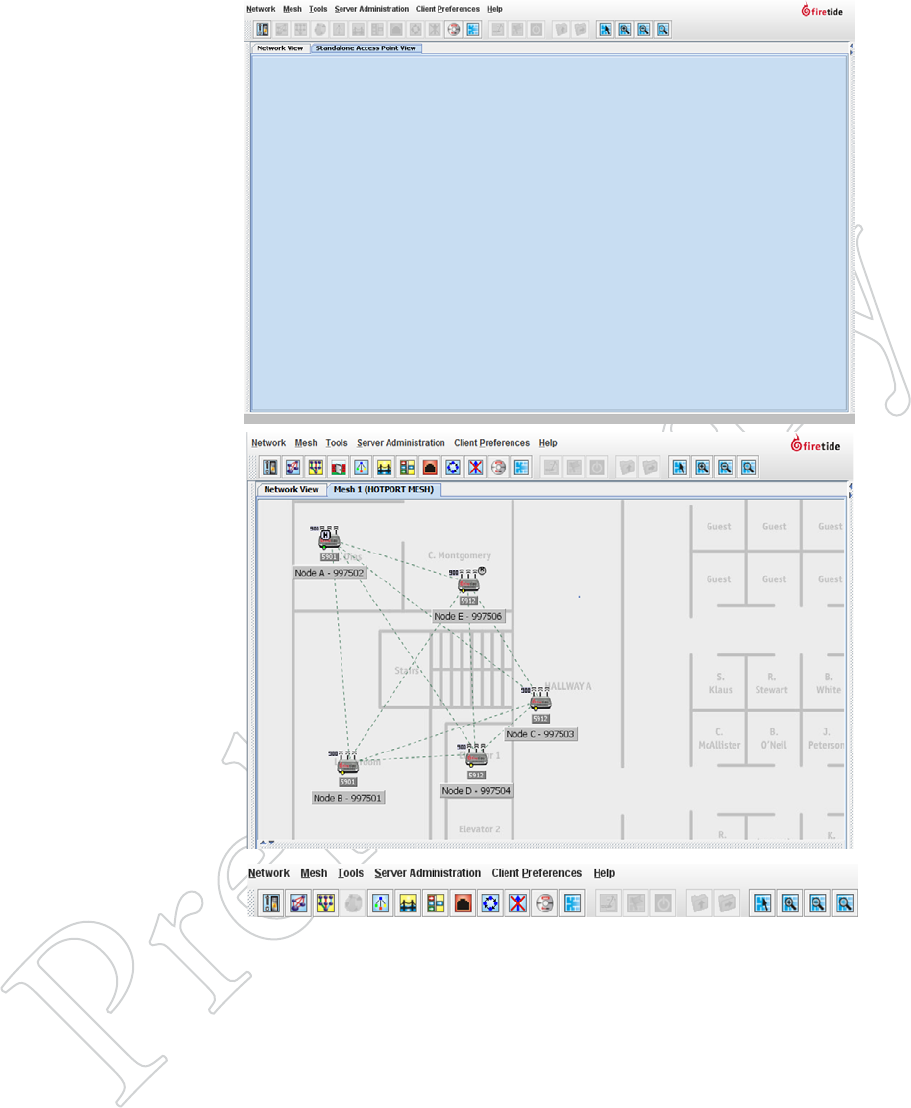
8 HotView Pro Software Operation
Figure 1.4 iNiTiAl ScreeN
When connecting for the first time,
you will see a screen similar this. No
mesh is visible because the server does
not yet know which meshes to man-
age.
Figure 1.5 AddiNg A MeSh
To add a mesh, click on the mesh
menu and select the Add Mesh com-
mand. Enter the mesh IP address. The
default is 192.168.224.150. Enter the
password. The default is firetide.
After about 30 seconds, the mesh
should appear. If it does not, insure
that the HotView Pro system is wired
to a node on the mesh, and that you
can ‘ping’ the mesh at its IP address.
You must use a wired connection to
connect to the mesh; you cannot con-
nect wirelessly.
Figure 1.6 MeNu coMMANdS
The menu commands are at the top
of the screen. Shortcut icons for many
commands appear just below the menu
commands
The menu commands are:
• Network: Used for certain network-wide functions, such as firm-
ware upgrades.
• Mesh: Has most of the commands needed for mesh configura-
tion and management.
• Tools: Provides certain tools for configuration and trouble-
shooting.
• Server Admin: Provides tools for configuring HotView Pro.
• Client Prefs: Affects the screen view.
These menu commands will be explained in more detail in the sections that
follow.
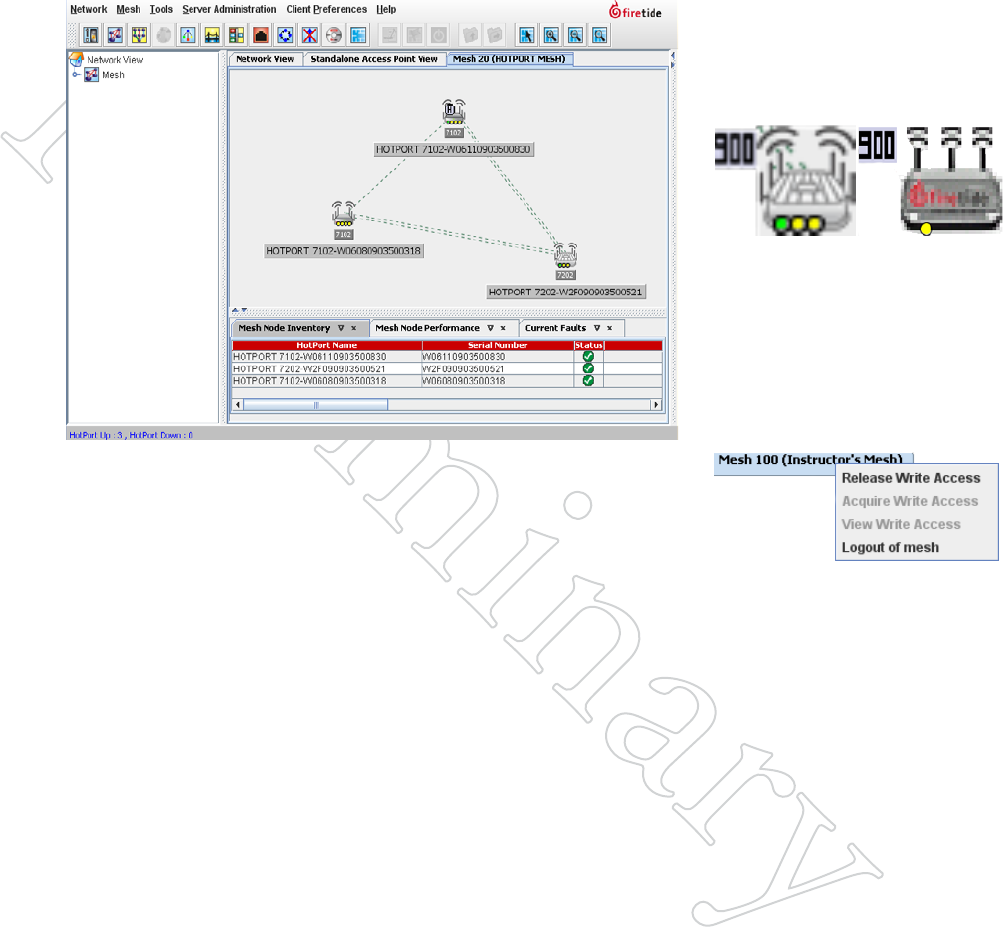
HotView Pro Command Summary 9
Understand the Basic Screen Layout
The HotView Pro screen layout varies according to settings. It can look
like Figure 1.4, the default view; Figure 1.5, the default view after adding a
mesh; or Figure 1.7, a typically-customized view. This customized view has
enabled the Explorer option, on the left of the screen. Along the bottom is
the Inventory window. At the very bottom is the status bar.
Figure 1.7 TypicAl ScreeN iMAge
This shows a typical screen view for a
simple three-node mesh
The menu bar includes numerous shortcut icons; at the far right are ones
for zooming in and out.
The nodes are in the central area, along with the background image of the
topography of the mesh installation. Just above them are multiple tabs; a
network view tab, one for access points, and as many mesh tabs as there are
meshes. These tabs can be right-clicked to access certain commands.
Of particular interest is the Logout of Mesh command. This is the opposite
of the Add Mesh command, and instructs HotView Pro to stop managing
that particular mesh.
HotView Pro is a multi-user system. Write-access control commands are
available via the mesh tab.
Figure 1.8 MeSh TAb coMMANdS
Right-clicking on the mesh tab lets
you log out of the mesh. It also con-
trols which user has write access to
that mesh.
Figure 1.9 Node icoNS
A 7000-900 is shown on the left; a
5900 on the right.

10 HotView Pro Software Operation
Figure 1.10 MeSh MeNu
This menu contains most of the
commands you will need for config-
uring and managing a mesh. These
commands can also be accessed by
right-clicking on the mesh area of the
display.
Mesh Menu Commands
Add Mesh causes HotView Pro to begin managing the mesh. The program
will record performance and events until the mesh is explicitly removed
from management control.
Configure Mesh displays a separate window which contains all of the key
mesh configuration commands. This is described in more detail in Figure
1.13 and following sections.
VLANs allows you to configure VLANs, VLAN trunks, and hybrid VLANs.
Multicast Groups allow you to define and control IP multicast traffic.
Mesh Bridges are connections between meshes. The Mesh Bridge Group
command creates these connections.
MAC Filters allow you to limit mesh access to a defined list of MAC ad-
dresses. Warning: careless use of this tool can lock you out of the mesh.
Ethernet Direct Connections are wired connections within a mesh. They
are an efficient way to connect nodes which are relatively close, but not
necessarily within radio range.
Static Routes can be used to steer traffic within the mesh. In most cases it
is better to let the AutoMesh™ protocol make path decisions, but there are
exceptions.
Link Elimination is used to force the mesh to ignore weak, marginal links
that sometimes spring up, unplanned, between nodes.
Apply Saved Mesh Configuration to the Entire Mesh is used to apply a
previously-saved configuration file to an entire group of nodes. (The con-
figuration file is created from an individual node; the command can be
found in the node-specific command section.)
Export Mesh Data for Analytics exports certain mesh performance data in
an Excel-compatible format.
Reboot Mesh causes all nodes on the mesh to reboot, but does not affect
any settings.
Delete Down Nodes (and Delete Down Mobile Nodes) removes ‘old’ nodes
from HotView Pro’s database of known hardware. The software normally
remembers all hardware and reports it as down; this command overrides
that.
HotPort Users Configuration lets you define and limit certain types of
Telnet and SSH access to the individual nodes.
Set Mesh/HotPort Statistics Refresh Interval lets you define how often
statistics are collection. The shortest interval is 300 seconds.
Show AutoMesh Route lets you examine the mesh’s choices for traffic flows
within the mesh.
Verify Mesh Configuration compares the mesh-wide settings on all nodes.
View Mesh Log displays a log of mesh events. It is searchable and filterable.
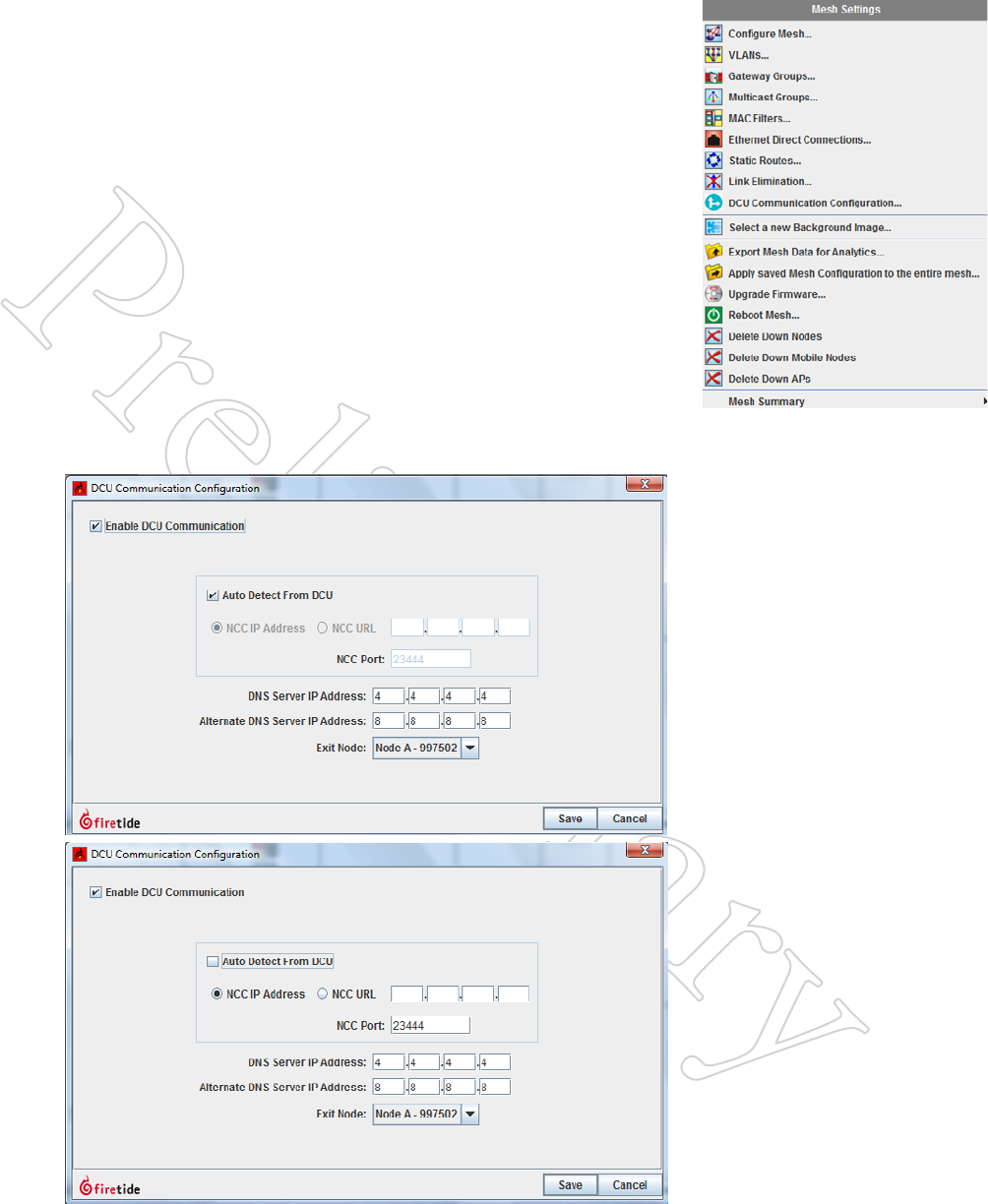
HotView Pro Command Summary 11
DCU Communication Conguration
The DCU Communication Configuration command is accessed by right-
clicking in the mesh area of HotView Pro, NOT on any node. This brings
up all mesh commands, plus the DCU-specific command.
The DCU expects to be able to communicate with the STAR Network
Communications Controller. The Firetide mesh node acts as a proxy for the
STAR NCC, and so it needs to know the IP addresses being used by that
particular deployment. In some deployments, the DCU already knows the
IP address, so the mesh can simply auto-detect it. In other cases, you must
program the IP address yourself.
Other deployments use a domain name instead of an IP address. You should
specify the address for a primary and secondary DNS. (Note that 8.8.8.8
and 4.4.4.4 are well-known DNS servers maintained by Google, and can be
used if another DNS server is not available.)
You must also specify the exit node. In all cases, be sure to check the Enable
DCU Communication checkbox. It can be turned off for certain debug
operations, but should normally be on.
Figure 1.11 righT-click MeSh
MeNu
This menu can be accessed by right-
clicking on the mesh area of the
display.
Figure 1.12 dcu coMMuNi-
cATioN coNFigurATioN - AuTo
deTecT vS MANuAl
In Auto-Detect mode, the system will
detect and use as many IP addresses as
the various DCUs might supply.
In Manual mode, you must supply a
single IP address.
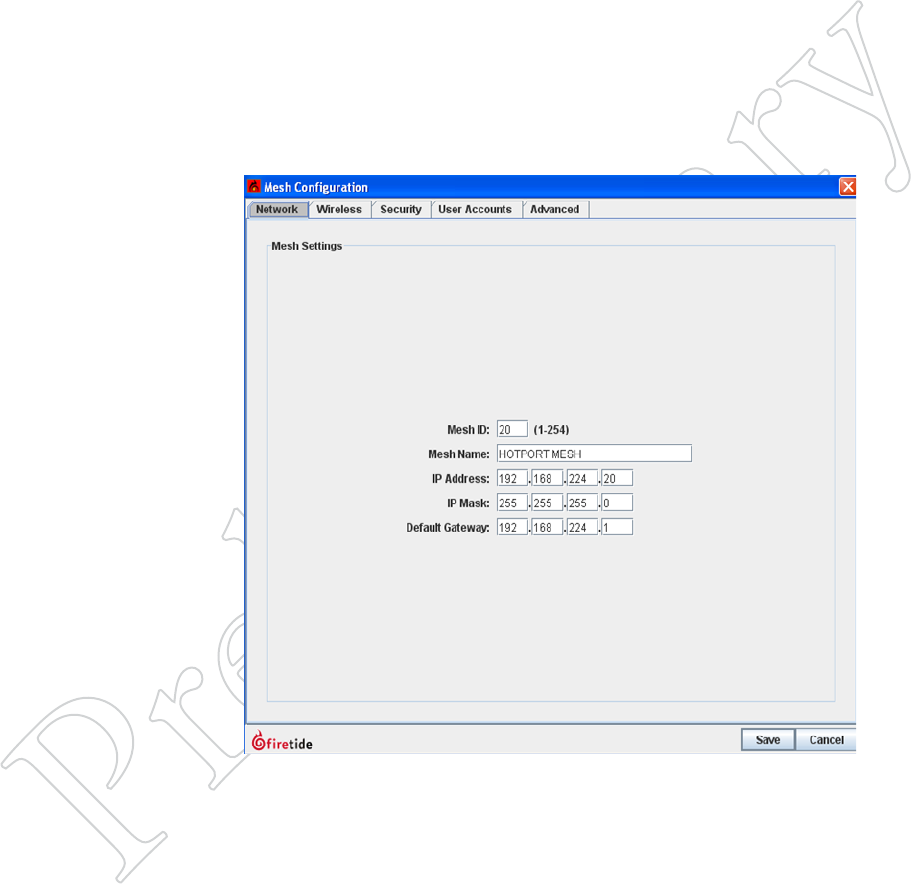
12 HotView Pro Software Operation
Figure 1.13 MeSh coNFigurATioN
The Mesh Configuration window has
five tabs, each of which affects a differ-
ent aspect of basic mesh configuration.
The Network tab allows you to assign
a unique ID number for the mesh.
The default is 1, legal values are
1-254. It also allows you to configure
the management IP address. This can
be anything.
Mesh Conguration
Mesh configuration is the heart of overall mesh design. Mesh configuration
includes network, wireless, security, and other key settings. There are five
tabs:
• Network This tab sets the IP address and related information, and
allows you to specify a human-readable mesh name.
• Wireless This tab controls most aspects of radio behavior. (Cer-
tain radio parameters, such as transmit power, are set on
a per-node basis.)
• Security This tab controls the encryption type and keys.
• User Accounts are the login credential used by the HotView Pro server
to access the mesh. These are NOT human logins.
• Advanced The advanced tab contains a number of configuration
and tuning options for meshwide operation.
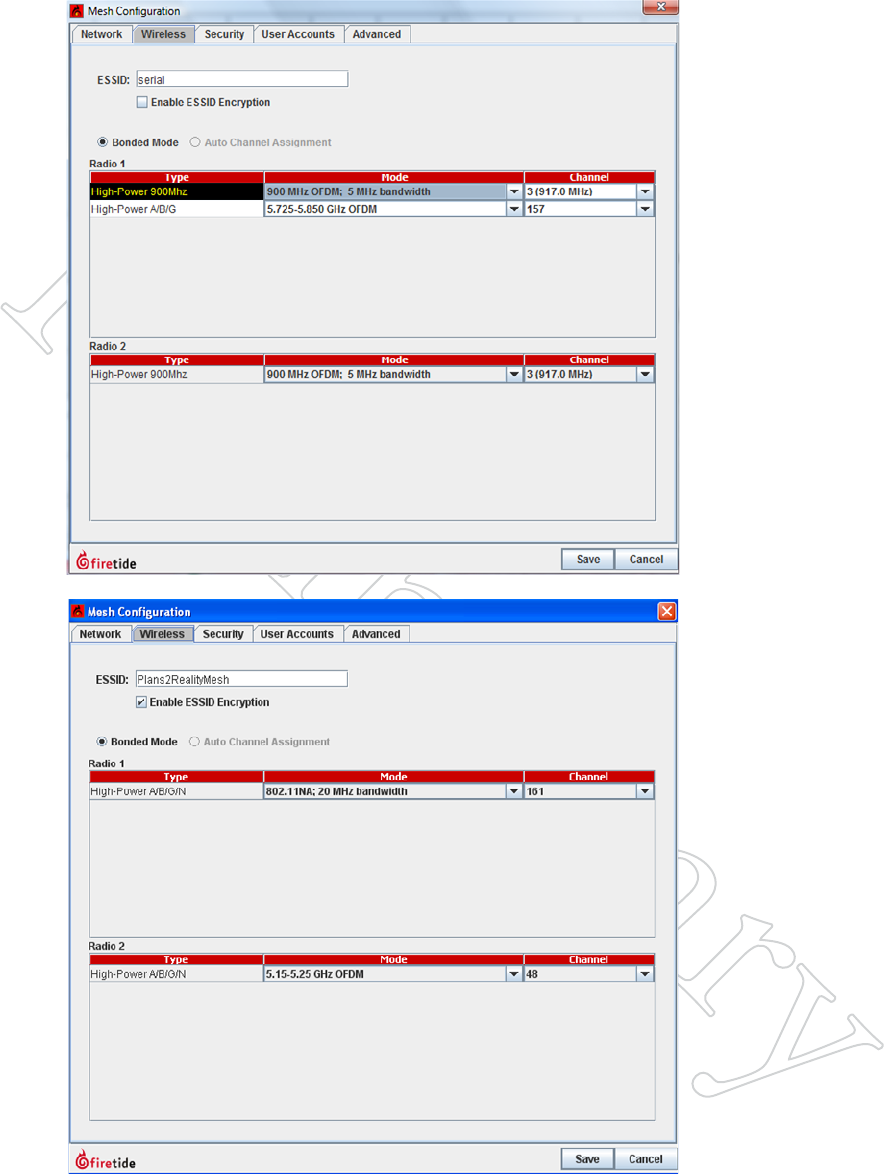
HotView Pro Command Summary 13
Figure 1.14 wireleSS SeTTiNgS
The Wireless tab lets you define (and
encrypt) the ESSID. More impor-
tantly, it lets you set mesh-wide radio
channels for all Radio 1 units in each
node, and all Radio 2 units in each
node. (Note: “Bonded” refers to the
fact that all Radio 1 units will be tied
together on one channel, and all Radio
2 units tied together on a second chan-
nel. It does NOT mean that Radio
1 and Radio 2 are tied together. The
two radios ALWAYS operate indepen-
dently.
Single-radio 5900 nodes have a 900
MHz radio for Radio 1. Dual-radio
nodes place a 2.4/5 GHz node in the
Radio 1 slot, and a 900 MHz radio in
the radio 2 slot.
Thus,depending on the node type,
Radio 1 can be a 900 MHz unit or a
2/4/5 GHz unit. This is why both fre-
quency ranges are shown for Radio 1
For each radio, the Mode drop-down
allows you to select frequency bands
and operating modes (a/b/g/n). The
choices available will vary with the
node configuration - one radio or two,
MIMO (802.11n) or non-MIMO, and
900 MHz.
The channel drop-down lets you select
from the channels available within the
chosen band.
The lower screen shows the wireless
options for 2.4/% GHz radios.
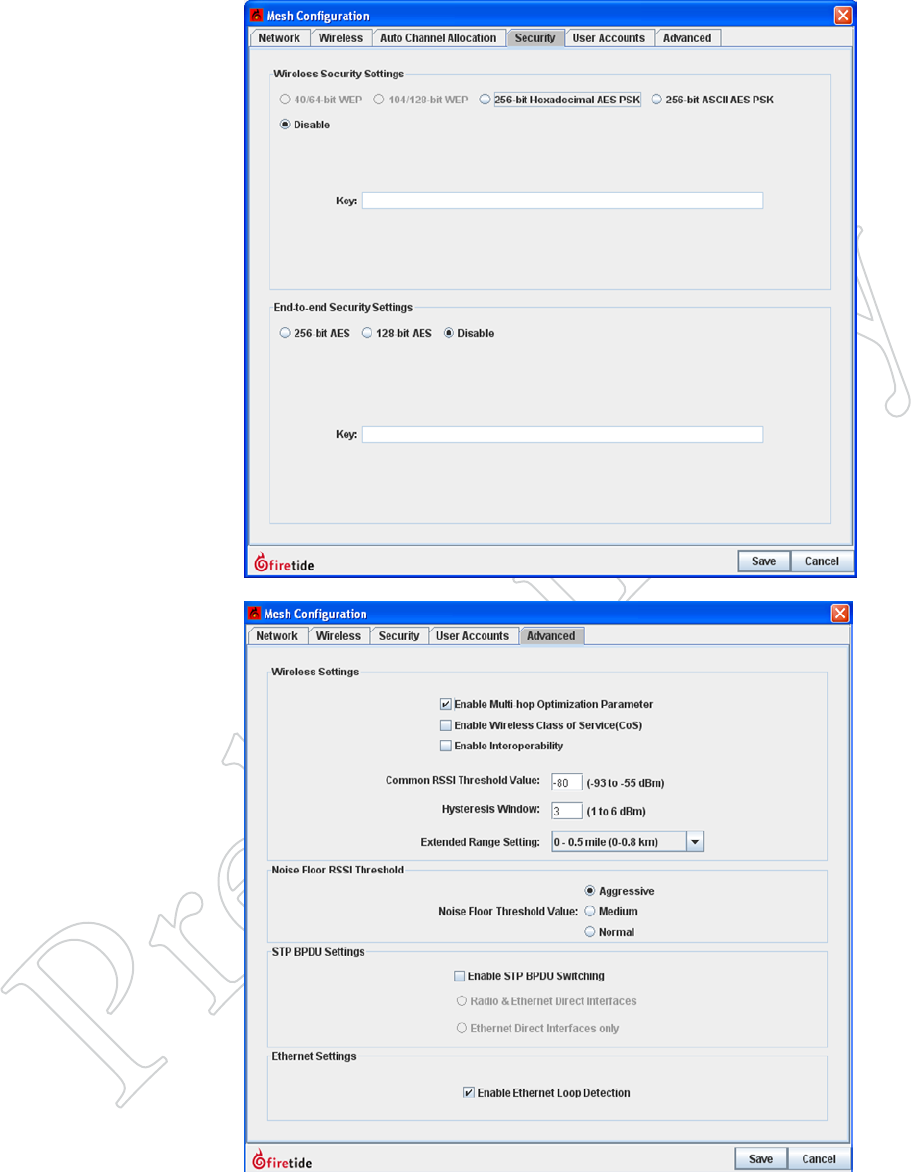
14 HotView Pro Software Operation
Figure 1.16 AdvANced TAb
The Advanced tab controls several key
features.
Multi-hop Optimization should be
turned on for all meshes with more
than two nodes.
Wireless Class-of-Service should be
turned on if you plan to support either
802.1p or port-based traffic prioritiza-
tion.
The RSSI Threshold Value and Hys-
teresis Window values can be used to
keep weak links from “flapping” on
and off, impacting mesh performance.
Ethernet Loop Detection is on by
default. It can be disabled, but do not
do so unless there is a good reason.
Figure 1.15 SecuriTy
The Security tab lets you enable
AES security on the RF links. This is
implemented in hardware and does
not impose a performance penalty. Its
use is recommended.
End-to-End security provides a second
layer of encryption, but imposes a
small throughput penalty, about 15%.
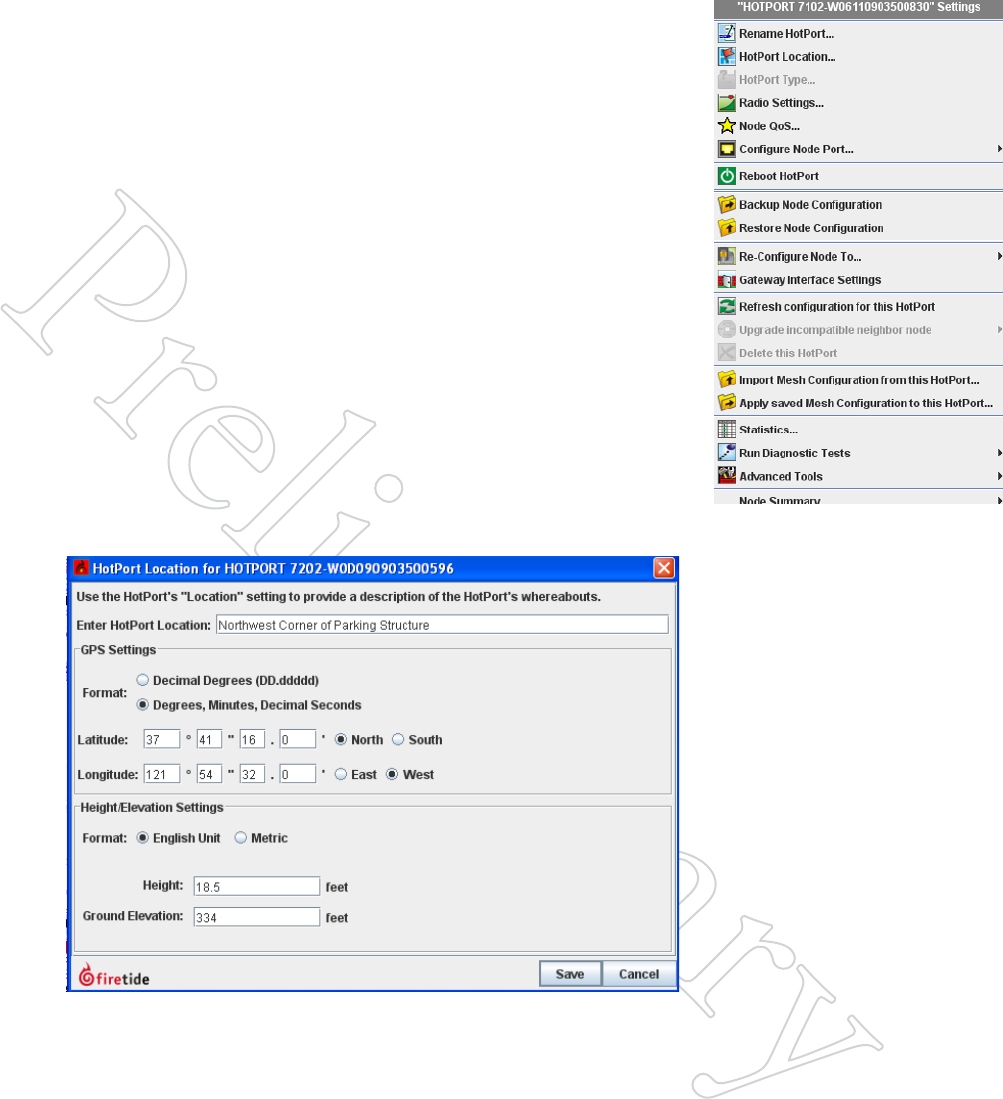
HotView Pro Command Summary 15
Figure 1.17 Node-SpeciFic
Node-specific commands can be ac-
cessed by right-clicking on a node.
Node Commands
Rename HotPort lets you assign a name to each node for management
purposes. This name can be up to 32 characters long. It is for the benefit of
network managers; the software is not affected by this entry.
HotPort Location lets you enter a 256-character string describing the loca-
tion of the node. You can also enter the latitude, longitude, and elevation of
the node. This is used by the antenna alignment tool to assist in alignment.
Radio Settings lets you over-ride mesh-wide radio settings, adjust transmit
power, and other things. It is covered in more detail in Figure 1.19.
Node QoS allows you to define 802.1p and port-based traffic priority. This
is described in more detail in Figure 1.20.
Configure Node Port has three sub-items in a flyout menu:
-Port Configuration lets you disable unused wired-Ethernet ports,
for security. It also allows you to manually configure port speed and
auto-sense.
-Hybrid Trunk Configuration is used as part of VLAN setup. Refer
to the VLAN chapter for details.
-VLAN ACL Configuration is used as part of VLAN setup. Refer to
the VLAN chapter for details.
Reboot HotPort reboots the node.
Figure 1.18 locATioN diAlog
wiNdow
Node-specific commands can be ac-
cessed by right-clicking on a node.
Backup and Restore Node Configuration allow you to make a backup file
of a configured node, and then restore the node settings to the node.
NOTE: this is not a backup tool in the usual sense of the term. A backed-
up node configuration CANNOT be applied to a different node. In other
words, this command cannot be used to configure a node in order to replace
a node that has failed in the field. A backed-up configuration file can only
be applied to the same serial-number node from which it was extracted.
The file created by the Backup Node Configuration command is encrypted
and is not human-readable.

16 HotView Pro Software Operation
Re-Configure Node To... lets you re-define the operating mode of a node,
to be either a normal node, a Gateway Server node, or a Gateway Server
Controller node. Gateway Servers and Gateway Server Controllers are de-
scribed in another chapter.
Gateway Interface Settings let you define the required parameters for
nodes which are part of a Gateway Group. Gateway Groups are covered in
another chapter.
Refresh Configuration for this HotPort node does just that.
Upgrade Incompatible Neighbor Node lets you upgrade the firmware on
a down-rev node. It is grayed out here because it is not applicable; there are
no down-rev nodes.
Delete this HotPort lets you remove the node from the software database.
Import/Apply Mesh Configuration... lets you create a file on your PC that
contains all of the mesh-wide settings. (E.g., it “imports” from the mesh
to the PC.) This is commonly used to back up mesh settings, and to then
apply them to new nodes so that they can join the mesh, using the Apply...
command.
NOTE: the mesh configuration files contain only basic mesh parameters.
They do NOT contain all aspects of system configuration. In particular
they contain no node-specific information, such as node names, local radio
settings, etc.
The mesh configuration files are written in XML, and can be viewed in a
browser; however, they are rather cryptic.
Statistics, Run Diagnostic Tests, and Advanced Tools are described in
another chapter.
Node Summary shows a summary of node settings.
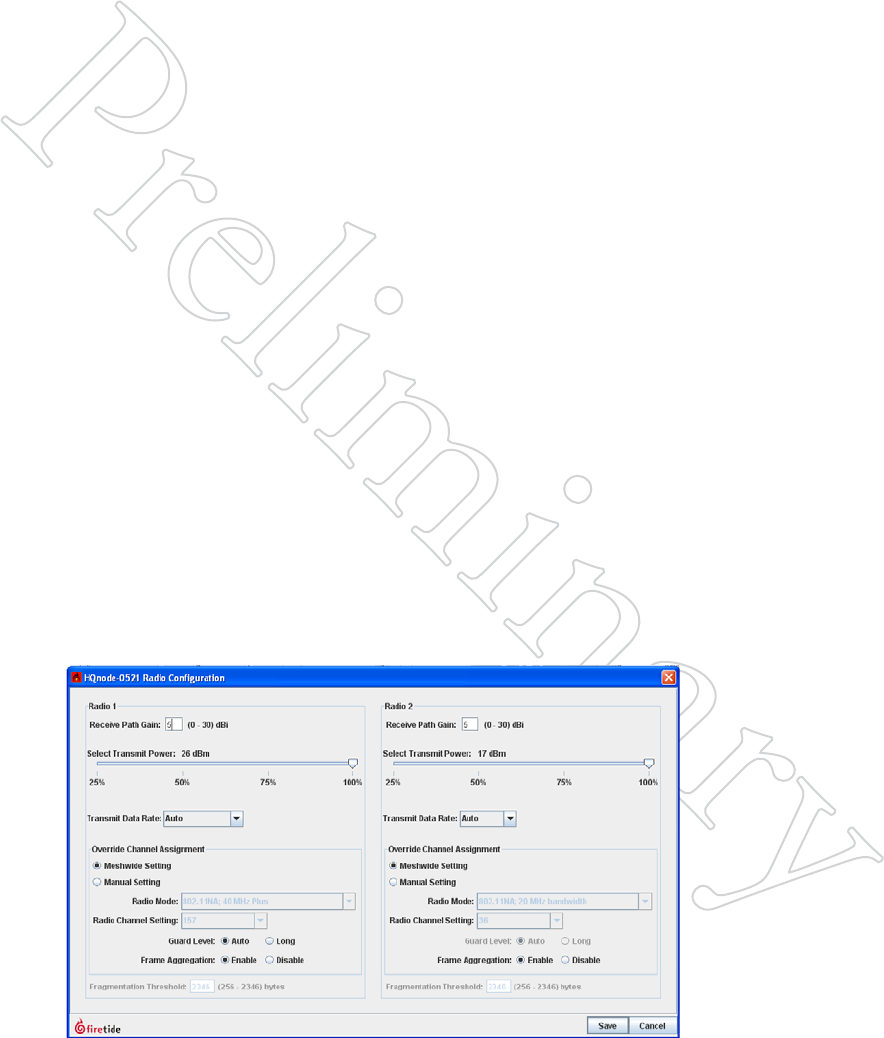
HotView Pro Command Summary 17
Figure 1.19 Node rAdio SeTTiNgS
The radios in each node can be config-
ured individually.
Each radio’s operating mode and chan-
nel can be changed from the mesh-
wide defaults. This is commonly done
in larger meshes to improve overall
throughput.
Individual Radio Settings
The two radios in each node can be individually configured. While a mesh
will generally work with uniform mesh-wide settings, in most mesh deploy-
ments better performance can be obtained by optimizing radio settings.
The individual radio settings are:
• Receive Path Gain - This setting calibrates the radar-detection func-
tion of the US FCC-mandate DFS feature. Refer to the
chapter on DFS for details.
• Select Transmit Power - Lets you to reduce transmit power in cases
where the receive strength (RSSI) at the link far end
is too high. In general, RSSI values stronger than -20
dBm can cause receiver overload, which increases the
error rate and therefore the number of re-transmissions
required. The exact level at which the receiver overloads
depends on the total amount of background noise, as
well as radio-to-radio variation.
• Transmit Data Rate - The maximum raw over-the-air data rate at which
the radio will attempt to operate; e.g. for 802.11a, 54
Mbps. Radios will automatically attempt to run at the
highest speed, but will fall back, then re-negotiate a
higher speed later. This adds jitter to a network. Limit-
ing the maximum data rate to a lower value reduces
jitter. Low data rate applications can be set to a lower
speed here, which reduces the RSSI requirement and
permits longer links or smaller antennas.
• Override Channel Assignment - refer to the chapter on channel assign-
ment for details.
• Fragmentation Threshold - Noisy RF environments may benefit from
a smaller packet size. The fragmentation size should be
reduced if retransmissions are common and other pos-
sible causes are eliminated. This option is not available
in 802.11n mode (as shown).
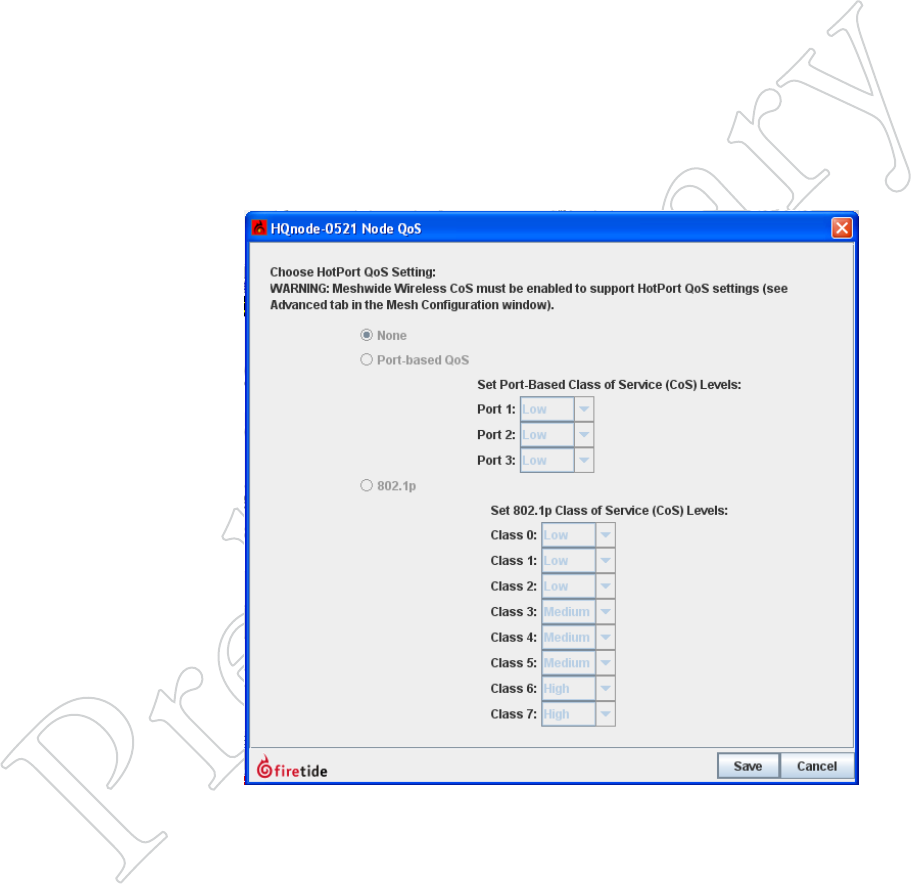
18 HotView Pro Software Operation
Figure 1.20 Node QoS
Two types of QoS are offered. 802.1p
QoS works with equipment that
supports that protocol, but many
devices do not. For devices that do not
support 802.1p, you can set priority
based on the port to which the device
is connected. For example, you might
place SCADA traffic, connected on
port 1, to High Priority, and video
traffic, connected on Port 2, to Me-
dium Priority.
Quality of Service
The Firetide mesh offers two Quality of Service (QoS) techniques.
• 802.1p - a standards-based method which lets you assign high, me-
dium, or low priority to any of eight classes of traffic.
• Port-based QoS - in order to support equipment which does not imple-
ment 802.1p, priority can be assigned per port. Traffic
entering the mesh on the specific port will be prioritized
across the mesh based on the port’s assigned priority.
Prioritization is applied to inbound traffic. If two pieces of equipment con-
nected to the mesh need high priority assigned to traffic in both directions,
both ports must be configured for high priority.
In video networks, it is common to set video traffic to medium or low pri-
ority, and other traffic to a higher priority, in order to ensure that the high
volume of video traffic does not ‘swamp’ other traffic.
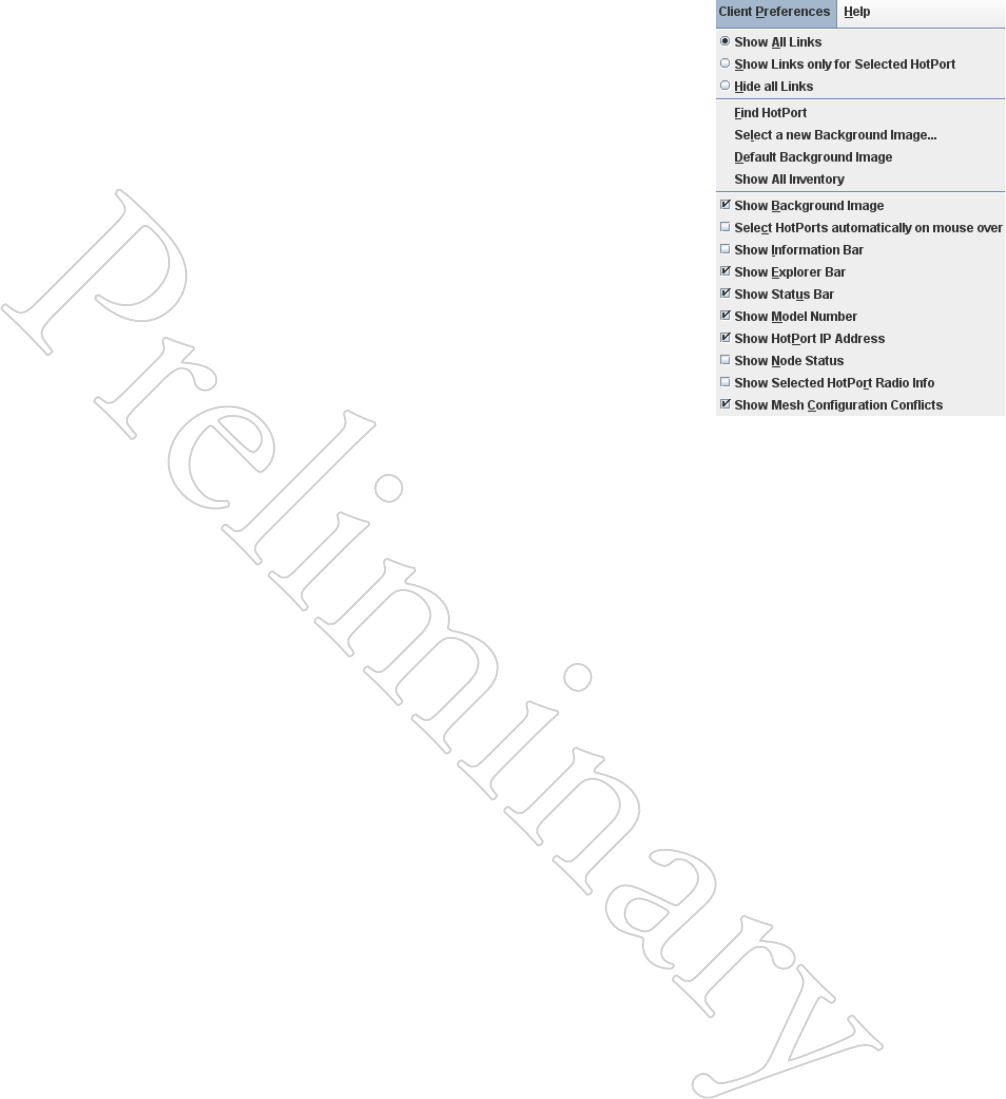
HotView Pro Command Summary 19
Figure 1.21 clieNT preFereNceS
The Client Preferences Menu lets you
control the user interface.
Client Preferences
Show All Links displays all of the active RF links in the mesh. For smaller
meshes, this is the preferred setting, but for larger meshes, it can make the
screen cluttered. In such cases, select the Show Links Only... or Hide All
Links options.
Find HotPort lets you search for a node on the display. The found node
will be highlighted.
Select New Background Image lets you replace the default image with a
graphical representation of the area where the nodes are installed. Typically
this is a floor plan or site map, represented as a bit-mapped file. You can
also switch back to one of two default background images. You can turn
the background image off altogether by unchecking the Show Background
Image button.
Normally a node must be clicked on to select it. Enabling Select HotPort
automatically on mouse-over does just that.
Show Information Bar opens a large section on the right side of the display.
This new panel can be used to examine most settings and node settings.
Show Explorer Bar opens a pane on the left side of the screen. This pro-
vides a hierarchical view of all meshes, nodes, and other equipment.
Show Status Bar displays the small status bar at the very bottom of the
display window.
Show Model Number displays the model number of each node under the
node’s icon.
Show HotPort IP Address reveals the hidden internal addresses the nodes
use among themselves. These are not visible or accessible from outside the
mesh, nor are they routable. They are used for certain internal tests only.
Show Selected HotPort Radio Info changes the display to show the Radio
1 and Radio 2 settings for each node when you click on the node. This is
very useful in multi-channel mesh designs.
Show Mesh Configuration Conflicts checks the settings on each node to
make sure they are in agreement.
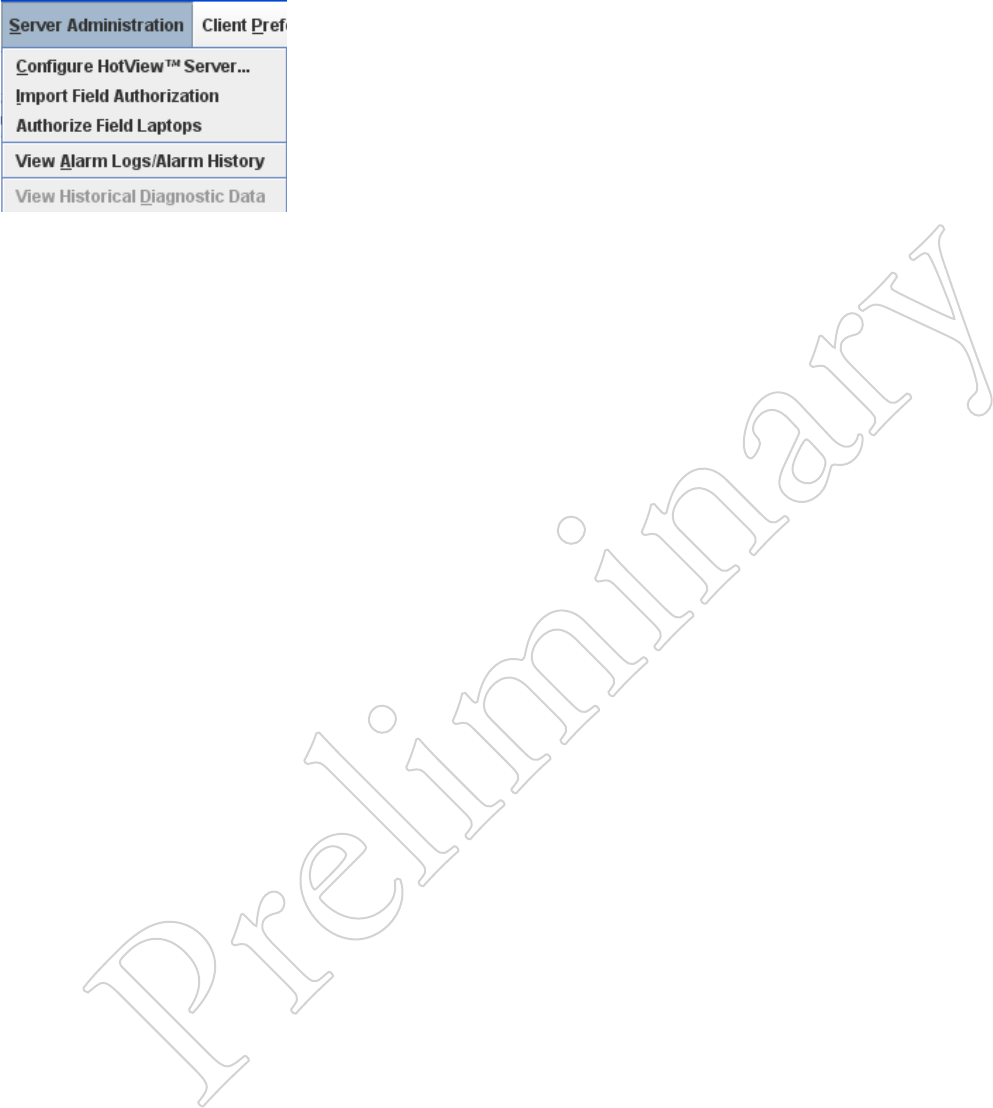
20 HotView Pro Software Operation
Server Administration
Configure HotView Server lets you configure all aspects of server behavior.
This is covered in more detail in “Server Configuration” on page 27.
Import Field Authorization and Authorize Field Laptops allow you to
delegate licensed managed authority to another computer; typically a lap-
top.
View Alarm Logs/Alarm History lets you view all past alarms. Alarm con-
figuration is defined in “Server Configuration - Alarm Management” on
page 30.
Figure 1.22 Server AdMiNiSTrA-
TioN MeNu
These commands let you configure
the server, and delegate management
control.
It also lets you view alarms for all
meshes under management.

Analyzing Performance 21
3 Analyzing Performance
Aspects of Performance Analysis
The HotView Pro software system has several tools to assist in analyzing,
troubleshooting, and optimizing system performance.
There are three basic aspects of performance analysis:
• RF signal quality
• Link throughput
• Reduction of link flap and other jitter sources
RF Signal Quality
The key element of RF signal quality is a good signal-to-noise ratio. Experi-
ence has shown that for 802.11a and 802.11g operating modes, a received
signal strength indicator (RSSI) of -70 dBm is the absolute minimum
strength required for reliable operation at full link speed. In RF-noisy envi-
ronments, a stronger signal may be required. It is common practice to de-
sign links to achieve -50 dBm or better, to provide a reasonable fade margin.
For 802.11n, the RSSI must be -60 dBm or better. Links should be engi-
neered to -40 dBm or better.
While it is unlikely to occur in the real world, extremely strong signals can
over load the radio receivers. Avoid RSSI values in excess of -20 dBm.
RF signal quality is also affected by interference from other RF sources,
and from incorrectly-configured meshes. These problems will show up as
dropped packets and retries in the statistics panel.
Possible sources of interference include other devices, but also the other
radio within the node. Dual-radio nodes should have antennas placed so
that their radiation patterns do not overlap.
An incorrectly-set range parameter or multi-hop optimization can also
cause collisions and dropped packets. Make sure multi-hop optimization is
turned on for all meshes with more than two nodes.
Make sure the range setting is larger than the longest RF link in the mesh.
If in doubt, set the range parameter larger than necessary to see if it solves
the problem.
Both of these parameters are in the Mesh Configuration window, Ad-
vanced tab.
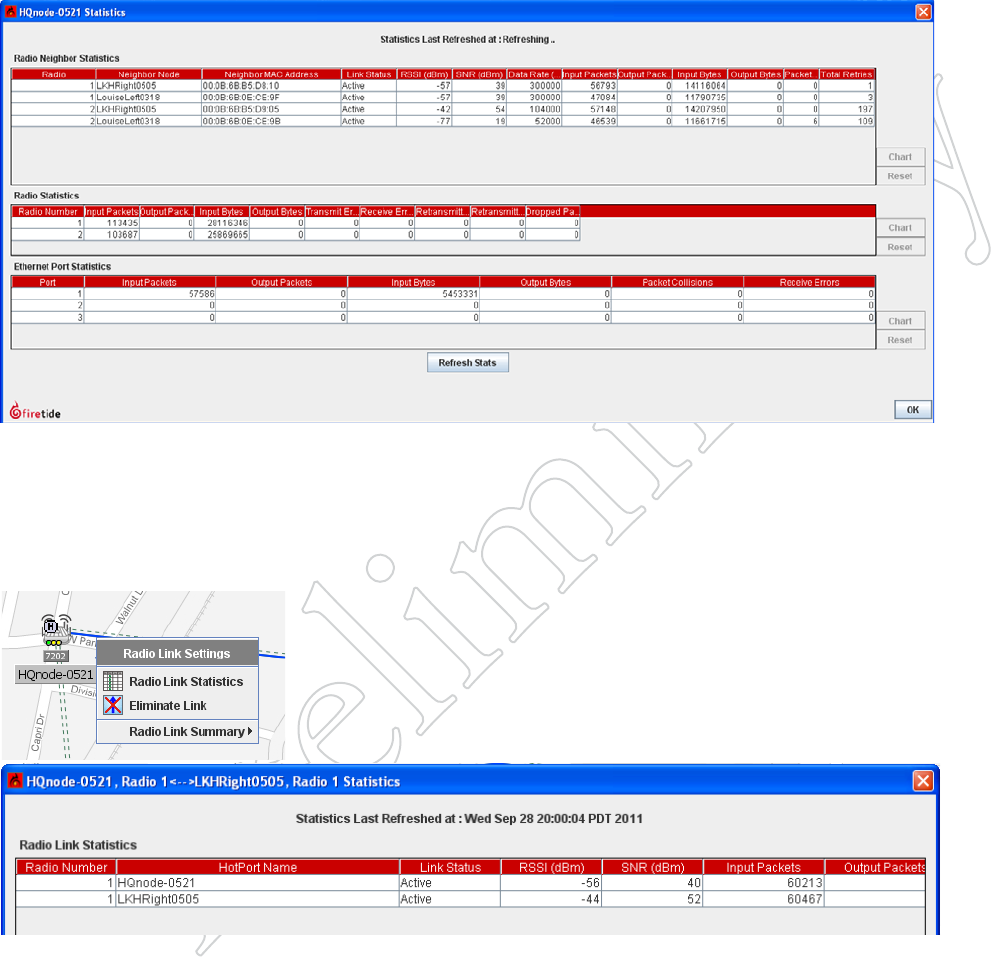
22 HotView Pro Software Operation
Figure 2.23 Node STATiSTicS
The node statistics window shows key
performance parameters for each radio
link on a node.
UNdeRSTANdiNg The Node STATiSTiCS wiNdow
Each radio has a one-line entry for each neighbor with which it is commu-
nicating. Columns 1, 2, and 3 identify the link.
Column 4 will show whether a link has been eliminated, usually because
it is marginal. Columns 5 and 6 show the RSSI and Signal-to-Noise ratio.
Column 7, Data Rate, shows the current modulation rate of the link. Note
that until there is traffic flowing over the link, this may remain at a low
value. Use the Run Diagnostics command to generate traffic if the mesh is
not busy.
Columns 8-12 show traffic in (received) and out (transmitted) for each link.
Columns 13 and 14 show dropped packets and total retries. It is normal to
have a few such events, but if either parameter exceeds about one percent of
total traffic, look for sources of interference.
Statistics for each link can be reset, and can be charted over time. Statistics
refresh automatically, but can also be refreshed via the button.
Figure 2.24 liNk STATiSTicS
Individual link statistics can be viewed
by first clicking on a link to select it,
and then right-clicking. Select the
Radio Link Statistics option.
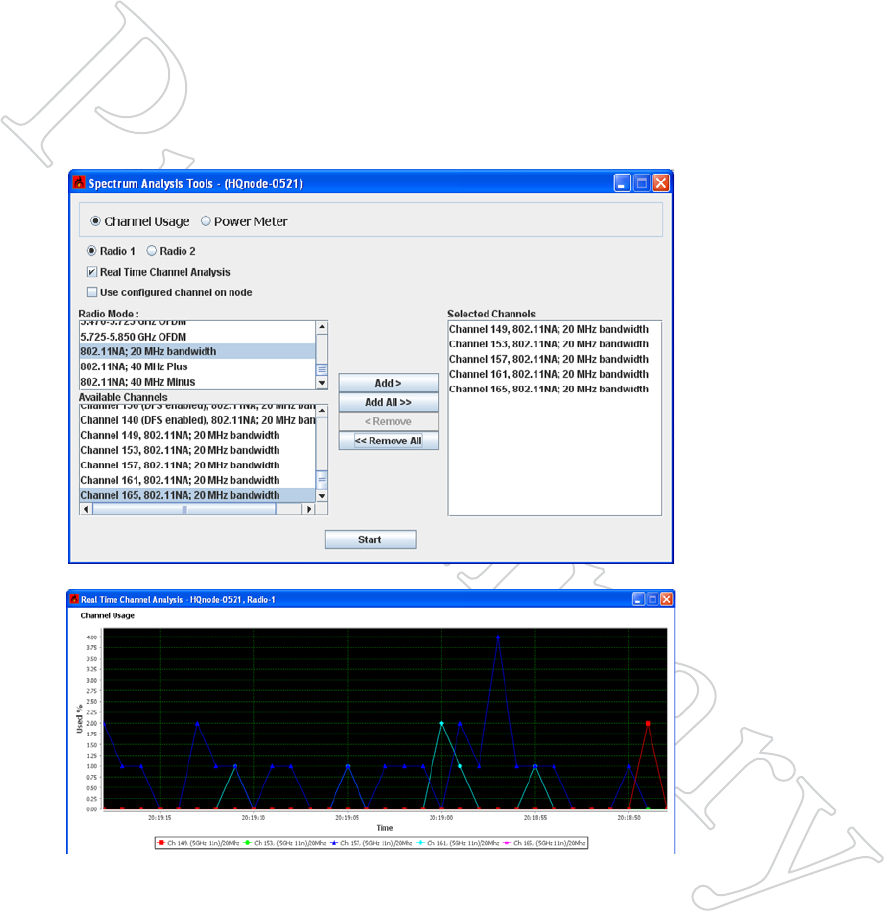
Analyzing Performance 23
SpeCTRUm ANAlySiS
The HotPort 7202 contains a spectrum analysis feature. This can be used to
scan for interference from all other sources, and record this information for
later analysis. It can be used for initial site survey work or to troubleshoot
problems that appear later.
Spectrum analysis works by using one radio in the node to sequentially scan
through the list of selected channels, recording the duration and power of
any RF signals it finds. The other radio in the node is used to communicate
the result back to HotView Pro, which stores the results and also displays
a graph of them. Note that the radio doing the scanning is out of service
and cannot carry mesh traffic. Plan accordingly when selecting a node and
radio for analysis work. You may wish to temporarily add an extra node to
an existing mesh.
Figure 2.25 SpecTruM ANAlySiS
SeTup
You can select either Channel Usage,
the percentage of time the channel is
in use; or Power, the strength of the
signal. The Power Meter mode will
also report the MAC address of the
transmitter; useful in determining
whether the signal is from one’s own
mesh.
You also select the radio mode and the
channels you wish to monitor. You can
monitor up to ten channels.
Figure 2.26 SpecTruM ANAlySiS
SeTup
This is the Channel Usage graph. The
upper graph shows instantaneous us-
age; the lower graph shows a longer-
period average.
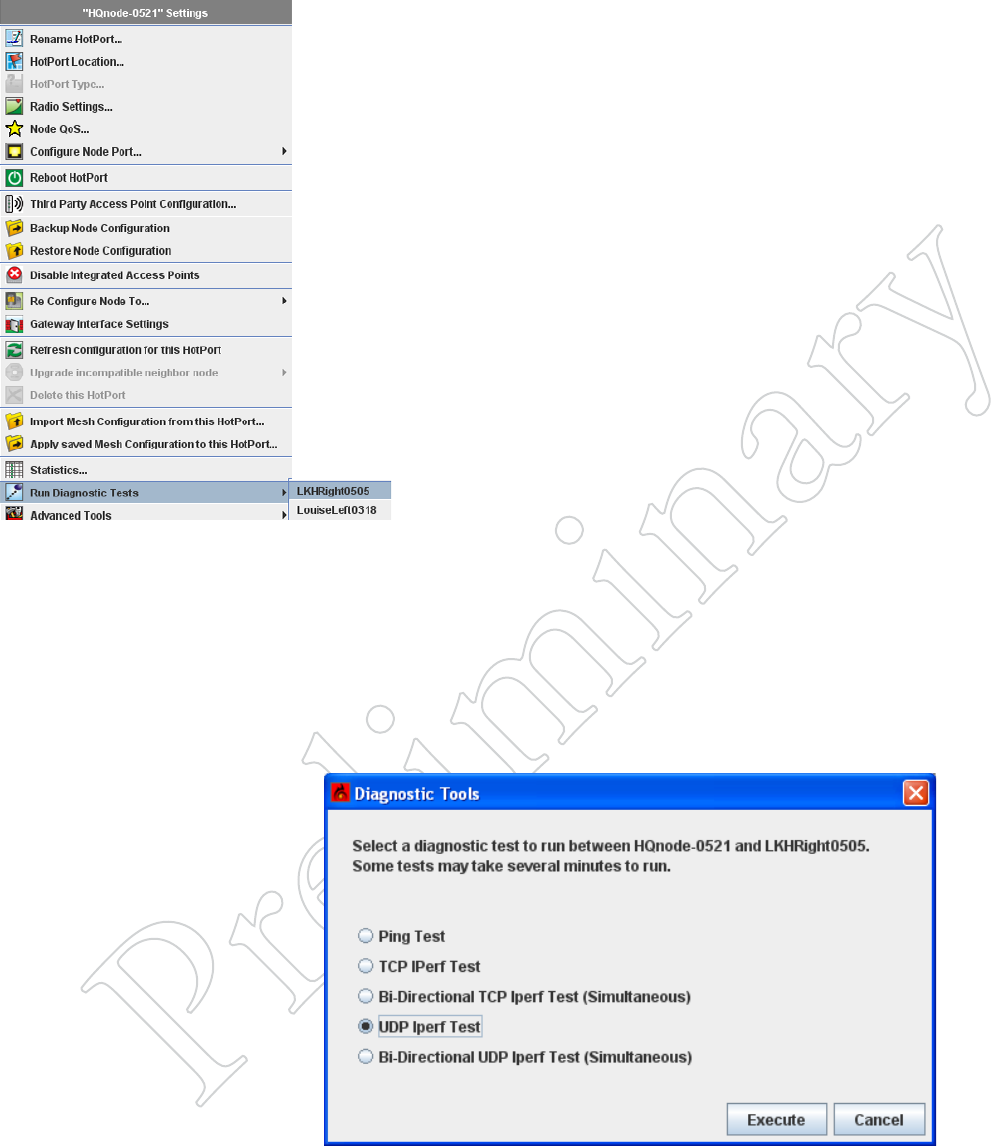
24 HotView Pro Software Operation
Figure 2.27 diAgNoSTic ToolS
The Diagnostics menu is accessed by
right-clicking on a node and selecting
the Run Diagnostic Tools option. A
flyout lets you select the second node
of the test pair.
Figure 2.28 diAgNoSTic Tool
SelecTioN
The Diagnostic Tools window lets you
select the test to be run.
Link Throughput
The ultimate goal of any mesh is to move traffic. While good RF perfor-
mance is necessary for this, you still need to verify actual effective through-
put. The HotPort 7202 has a built-in performance tool to make this easy.
To measure performance, right-click on one of the two nodes between
which you wish to measure performance. Select Run Diagnostics Tools, and
select the second node from the flyout. You will be presented with a window
from which to select the desired test.
There are five choices:
• Ping - this runs a simple ping between nodes to verify that the RF link
is functioning. It does not generate enough traffic to affect overall mesh
operation. The ideal result is a low, but consistent, ping response time.
Highly inconsistent times indicated RF signal problems.
• TCP Iperf & Bi-Directional TCP Iperf. Both tests run a large amount
of TCP traffic between the nodes, on one link. The difference is that
the bi-directional test runs it in both directions simultaneously.
• UDP Iperf and Bi-Directional UDP. Both tests run a large amount of
UDP traffic between the nodes, on one link. The difference is that the
bi-directional test runs it in both directions simultaneously.
Note: the Iperf tests flood the chosen link with as much traffic as it can
carry. This may disrupt other traffic on the mesh. Iperf attempts to send
a large, fixed amount of traffic. It will time out if it is unable to complete
the entire transfer in a fixed period of time, so you will occasionally see a
“test failed” message. Re-run the test. If it fails consistently, it means there
is substantial interference on the RF link.
Also note that the CPU in the HotPort 7202 can only run iPerf traffic at
about 115-120 Mbps; thus it cannot fully test a 40 MHz 802.11n link.
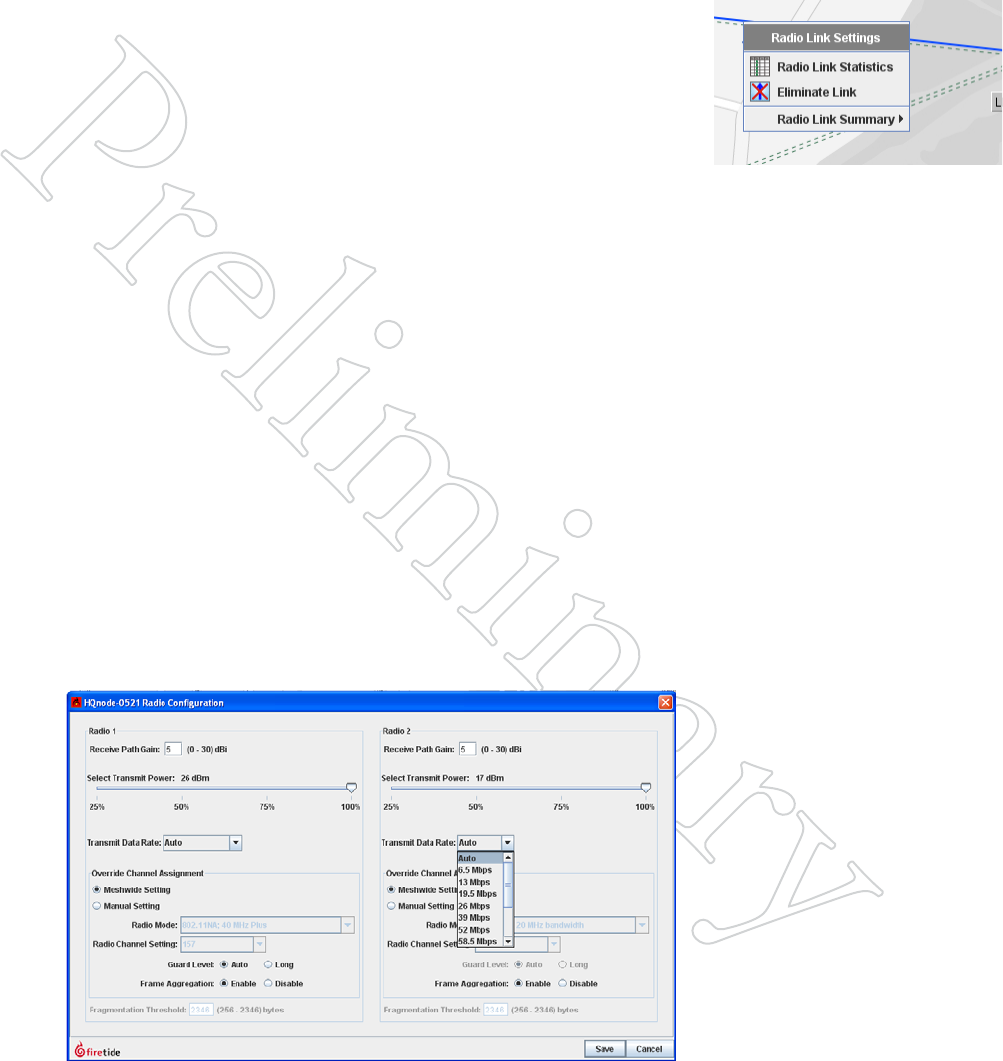
Analyzing Performance 25
Performance Optimization
Once basic mesh performance has been verified, the mesh should be tuned.
There are two parts to this; both involve reducing mesh overhead traffic and
reducing mesh jitter.
Link Elimination
It is not uncommon to have nodes in the field form links among themselves
that were unplanned; i.e., not needed as part of the mesh design. Because
the nodes continuously update each other about the state of each link in the
mesh; the more links there are the more overhead there will be.
Worse, unexpected links are usually of marginal quality; thus they are likely
to drop out and recover as RF conditions change. This is a condition called
‘link flap’ and it too generates overheard traffic.
The easiest way to eliminate links is shown in Figure 2.29. There is also a
Link Elimination command under the Mesh menu.
Fixing Maximum Data Rates
802.11 radios automatically negotiate the best speed possible under the ex-
isting RF conditions. If this is less than the maximum, the link will attempt
to negotiate the speed upward, and then fall back again when necessary.
In most applications this is completely transparent and also irrelevant.
However, in mesh applications it can introduce small amounts of jitter in
mesh transit times, and it also creates more mesh overhead traffic, because
the nodes share link speed information for routing purposes.
It is often useful to adjust the maximum possible speed at which an RF link
can operate to a value less than the maximum. This has only a modest effect
on performance but can reduce overheard and jitter. This is usually a ben-
eficial trade-off in meshes which are carrying video or voice traffic. Figure
2.30 shows an example.
Figure 2.29 liNk eliMiNATioN
Selecting an RF link by clicking on it
will highlight the link in blue. Right-
clicking brings up a pop-up which lets
you eliminate the link
Figure 2.30 FixiNg dATA rATeS
Individual RF links can have their
maximum data rate specified via the
Radio Configuration option on each
node; accessible by right-clicking the
node.
Here, Radio 1 has been set to 36
Mbps, and Radio 2 shows the drop-
down menu of available radio speeds.
The speed choices vary according to
radio type operating mode

26 HotView Pro Software Operation
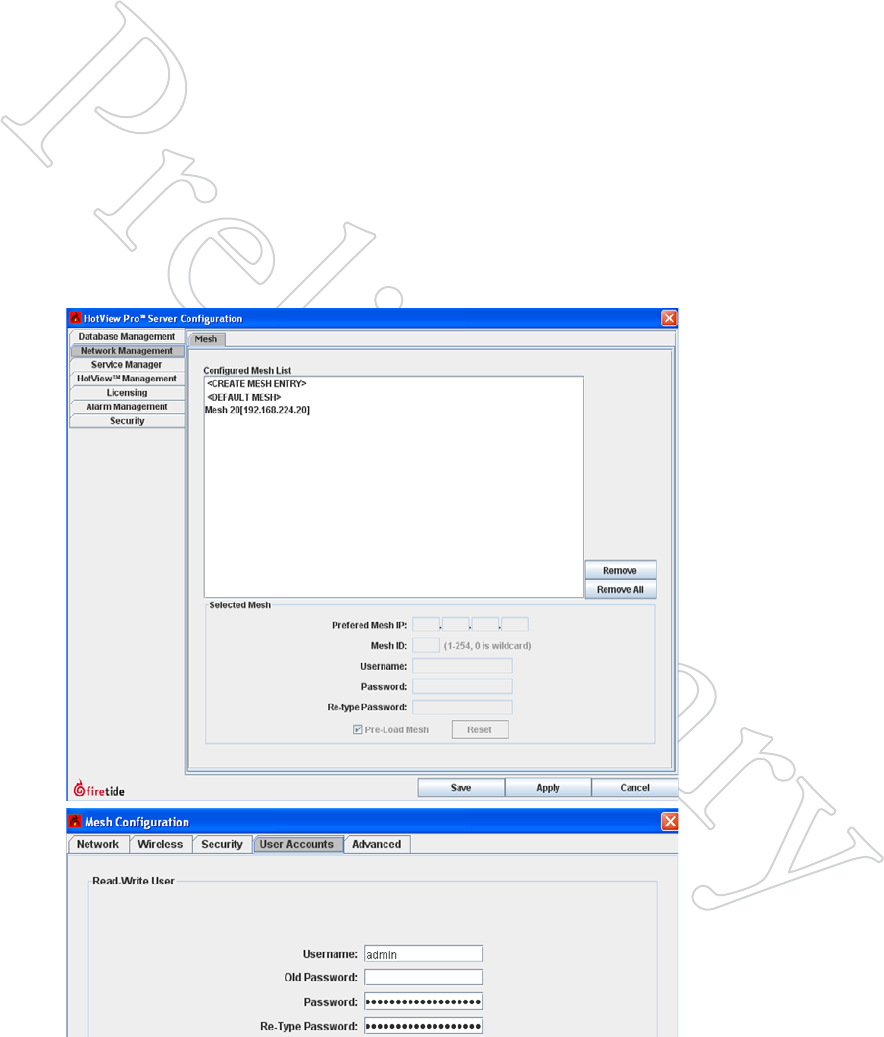
HotView Pro Server Conguration 27
4 HotView Pro Server Conguration
This chapter explains how to configure the HotView Pro server application
itself. The server is the always-on element of the overall system; thus it man-
ages alarms, defines user accounts, and performs many other network-wide
functions. The server can be configured whether it is running or not. To do
so when it is not running, use the Server Configuration icon in the Hot-
View Pro Launcher window, at the bottom of “Figure 1.3 Launcher Win-
dow” on page 7. Otherwise, click on the Server Administration menu.
As shown in Figure 3.31, the Server Configuration window has seven tabs
along the left side, with a varying number of sub-tabs along the top. The
Database Management and Licensing functions are covered in the software
installation document. The other tabs are described herein.
Server Conguration - Network Management
Figure 3.31 Server coNFigurA-
TioN - NeTwork MANAgeMeNT
This tab shows the meshes, access
points, and controllers that are under
management by HotView Pro. In
particular, it lets you tell the server
application what the login credential is
for each mesh.
It also allows you to remove from the
server’s database any mesh which you
no longer wish to manage.
Note: the mesh username and
password here do not represent the
humans who use the system; instead it
is the login credential specified in the
Mesh Configuration window under
the User Accounts tab. This is shown
in Figure 3.32.
Figure 3.32 MeSh uSer Ac-
couNTS
This tab defines the login information
that the server uses to access the mesh.
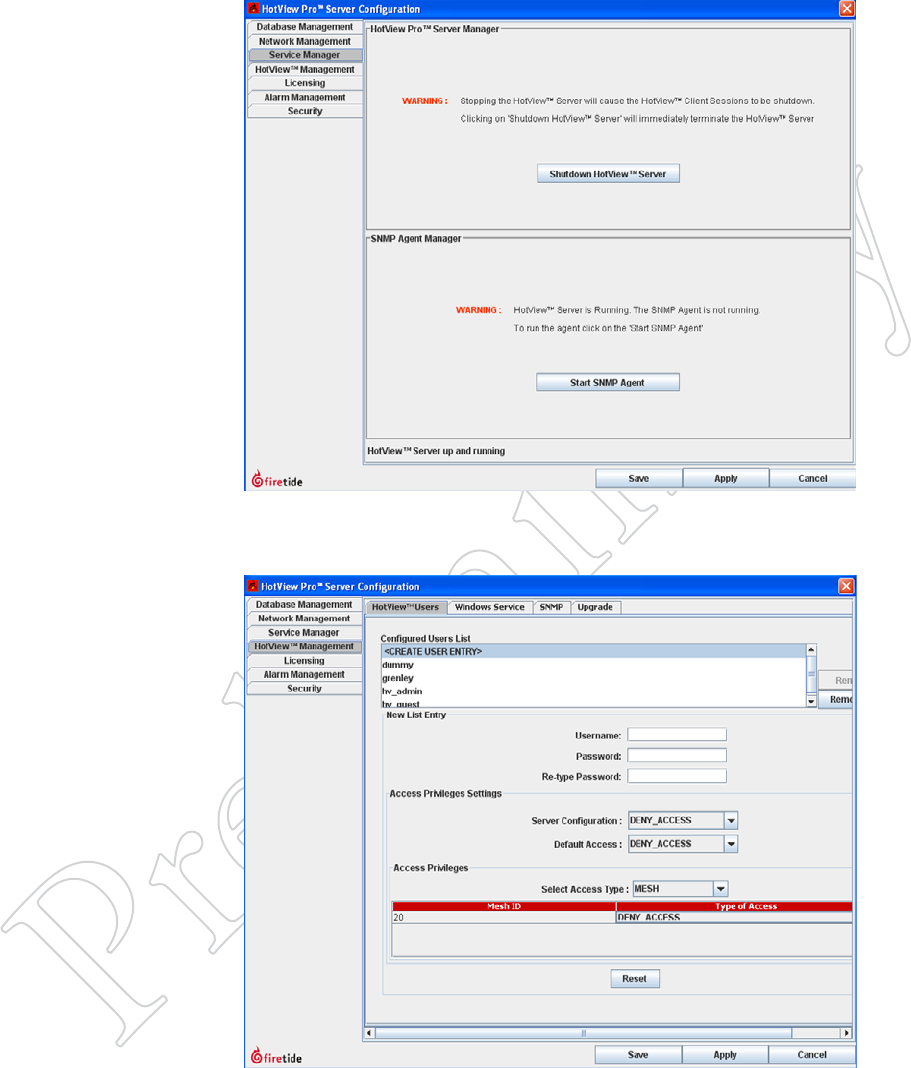
28 HotView Pro Software Operation
Figure 3.33 Service MANAger
The Service Manager tab are used to
start and stop the server application
and the SNMP agent application.
Figure 3.34 hoTview pro MAN-
AgeMeNT - uSerS TAb
This tab defines accounts for human
users of the system.
Each user can be granted or denied
server admin privileges.
Each user can also be granted read/
write access to meshes, read-only ac-
cess, or no access at all.
Server Conguration - Service Manager
Server Conguration - User Management
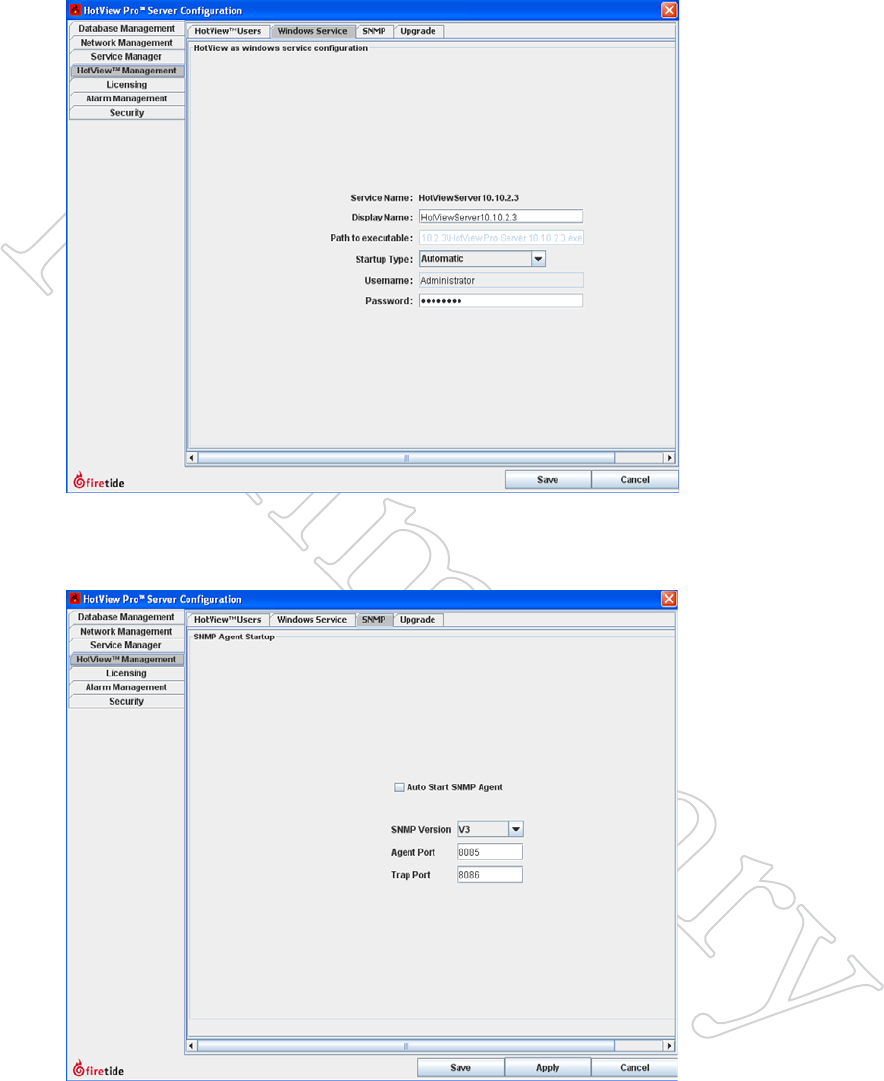
HotView Pro Server Conguration 29
Figure 3.35 hoTview pro MAN-
AgeMeNT - wiNdowS Service TAb
This tab lets you configure the server
application as a Windows service, so
that it starts (and re-starts) automati-
cally.
Figure 3.36 hoTview pro MAN-
AgeMeNT - SNMp TAb
This tab lets you configure the SNMP
agent.
Server Conguration - Windows Service Manager
Server Conguration - SNMP Setup
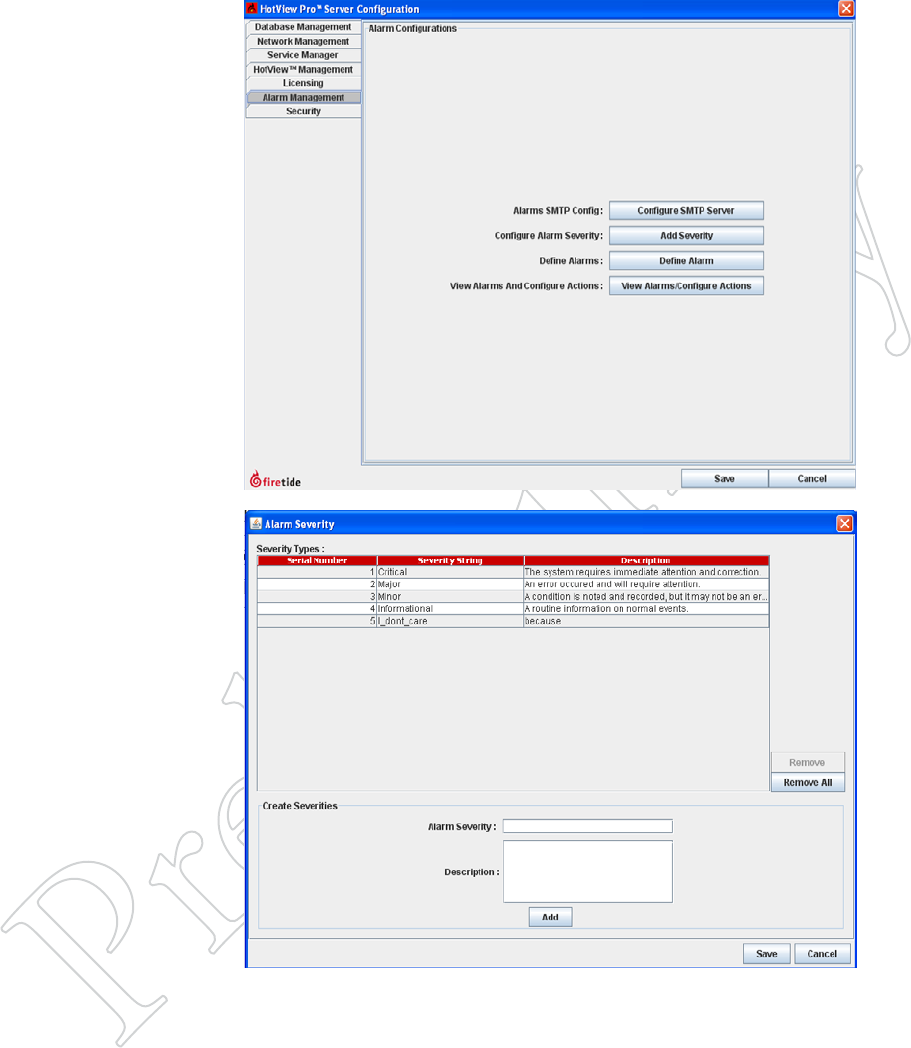
30 HotView Pro Software Operation
Figure 3.37 AlArM MANAgeMeNT
The server can be configured to gener-
ate alarms. There are four aspects to
alarm configuration and generation:
• Alarm Definition
• Alarm Severity Definition
• Alarm Action Configuration
• Alarm email (SMTP) Configuration
Figure 3.38 AlArM coNFigurA-
TioN - SeveriTy
There are four pre-defined levels of
severity. Additional levels may be
defined if needed.
Server Conguration - Alarm Management
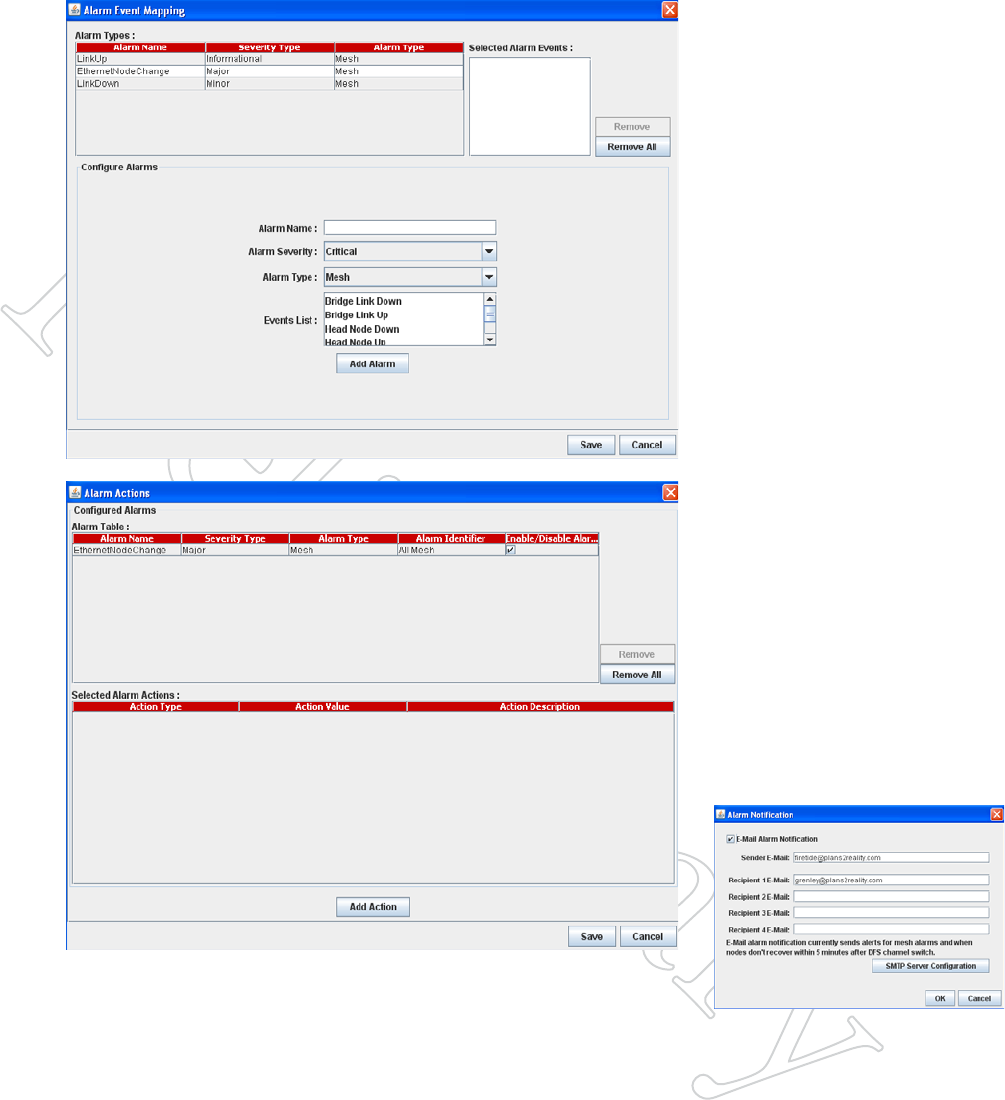
HotView Pro Server Conguration 31
Figure 3.39 AlArM eveNTS
This tab lets you select from a list of
alarm events to create named alarms
with associated severities.
Actions to be taken for each named
alarm are defined in Figure 3.40.
Figure 3.40 AlArM AcTioNS
Named alarms can be assigned actions
using this window. Actions include:
• Execute a System Command.
This causes the named system com-
mand program to be executed.
• Send an email.
• Do nothing (but write a log entry).
• Ignore.
If email is select, email parameters
must be specified, as shown below:
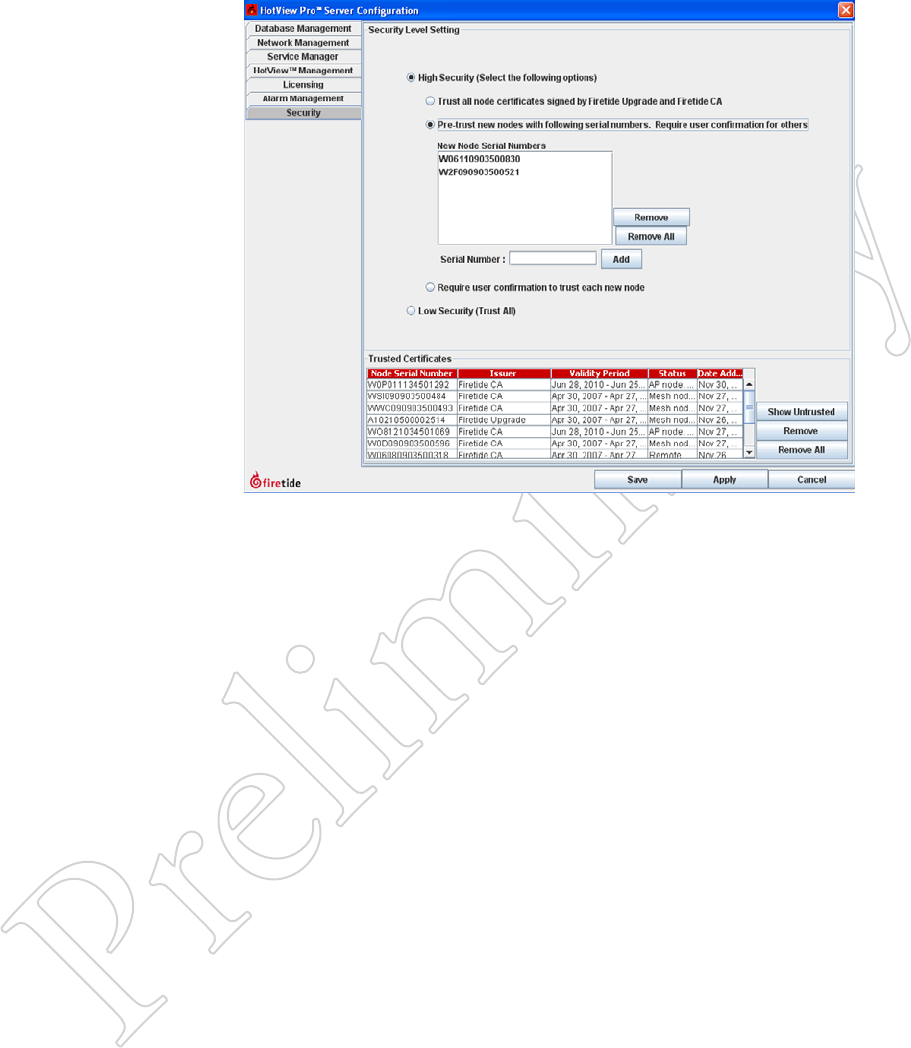
32 HotView Pro Software Operation
Figure 3.41 SecuriTy
This tab lets you restrict the ability of
nodes to join the mesh.
Normally, any node with the cor-
rect mesh settings can join the mesh.
Enabling High Security requires that
the node have a valid, digitally-signed
certificate issued by Firetide.
It can further be restricted by requir-
ing the server to obtain explicit human
approval before allowing a node to
join the mesh.
Server Conguration - Security

Upgrading Firmware 33
5 Upgrading Firmware
This chapter explains how to upgrade firmware in your nodes. The ‘up-
grade’ tool is general-purpose; it can be used to upgrade firmware to a new
release, roll back to an old release, or reload the same version. The up-
grade tool is resilient and fault-tolerant. All firmware images are verified by
checksum, and activation of the new image (reboot) does not occur unless
a valid image is received. Activation can be delayed, so that firmware can be
upgraded and ‘ready to go’ awaiting later activation.
wheN To UpgRAde
From time to time, new firmware is released to address bugs, improve per-
formance, or add features. Consult the release notes to help you decide
whether the upgrade is applicable to your mesh. If you decide to upgrade,
be sure to upgrade all nodes within a mesh. Firetide does not recommend
operating a mesh with mixed firmware levels.
Some firmware upgrades require a new version of HotView Pro. If this is
the case, upgrade the firmware first, then switch over to the new version of
HotView Pro.
UpgRAde opTioNS
In general you will want to upgrade all of the nodes on a mesh at the same
time, then activate. Use care when upgrading nodes and meshes. Firmware
upgrades can consume considerable bandwidth. If you are planning an up-
grade of a production mesh, upgrade only a few nodes at a time, and use the
Activate Later command to schedule the activation/reboot for a convenient
time. Note that the mesh will be offline for about two minutes when the
new firmware is activated.
However, firmware upgrades can consume considerable bandwidth. There
are several steps you can take to minimize the effect on the mesh, should
this be necessary.
• You can upgrade only a few nodes at a time.
• You can use the Activate Later command to schedule the activation/
reboot for a convenient time.
• You can reduce the block size used during upgrade.
Note that the mesh will be offline for about two minutes when the new
firmware is activated.
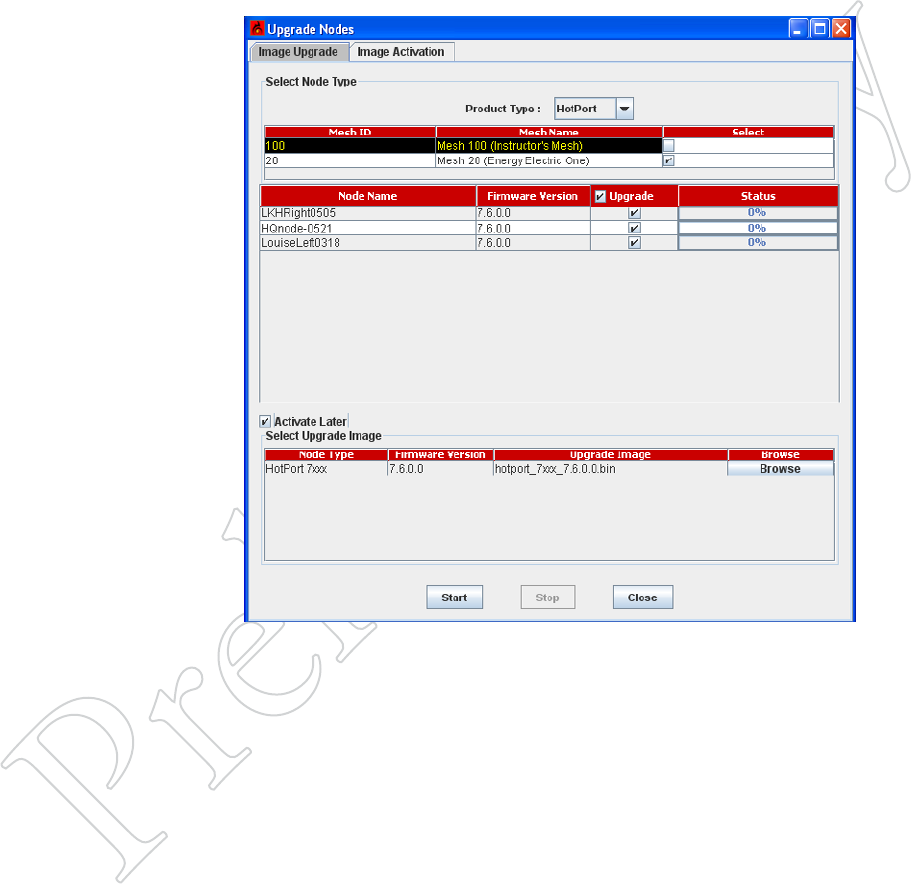
34 HotView Pro Software Operation
Figure 4.42 FirMwAre upgrAde
The upgrade window shows the
meshes available for upgrade, and the
nodes within each mesh.
It also allows you to select the firm-
ware image you wish to apply to the
nodes.
There is an Activate Later check-box
and an image activation tab. This
allows you to schedule the activation
time.
Here, an image file has been selected.
Image file names have a specific
format; it includes the product type,
numerical family number, and version
number.
Suffixes can be either .bin or .bin2; the
.bin2 option is digitally signed. Refer
to the Security section for details on
digitally-signed firmware versions.
how To UpgRAde
To upgrade, begin by selecting the Upgrade Firmware command from the
Network menu. A window opens, similar to the one in Figure 4.42. This
shows the nodes available for upgrade. Check boxes let you select the nodes
to be upgraded.
In most cases, an entire mesh can be upgraded at once. If you choose to do
so, select the Activate Later icon. Activate after you have verified that all
nodes have received valid images.
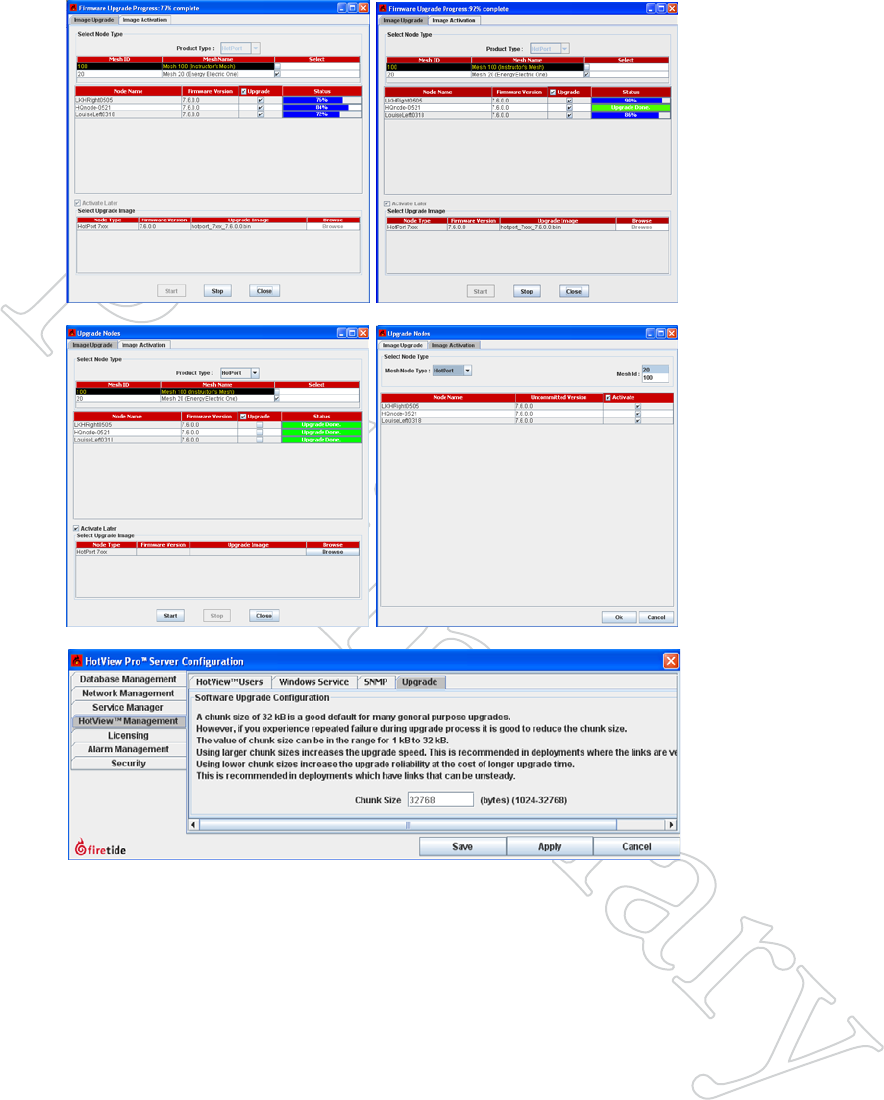
Upgrading Firmware 35
Figure 4.44 coMpleTioN & AcTi-
vATioN
The Image Activation tab lets you
activate the previously-uploaded image
at a time of your choosing.
Note that this means the nodes will re-
boot, and be offline for approximately
two minutes.
Figure 4.43 upgrAde iN progreSS
These images show the progression of
the firmware upload.
Note that the ‘upgrade complete’
message does NOT mean that the new
image has been activate, i.e. run, but
only that it has been uploaded and
fully checked for accuracy.
Also note that the Activate Later op-
tion has been selected.
Figure 4.45 upgrAde chuNk Size
You can specify a smaller chunk size
for the firmware upgrade process.
This will increase the time it takes
to perform an upgrade, but will also
reduce the impact on production
network traffic. It is also recommend
if you must upgrade a mesh that is
experiencing high levels of interference
or intermittent connections.

36 HotView Pro Software Operation